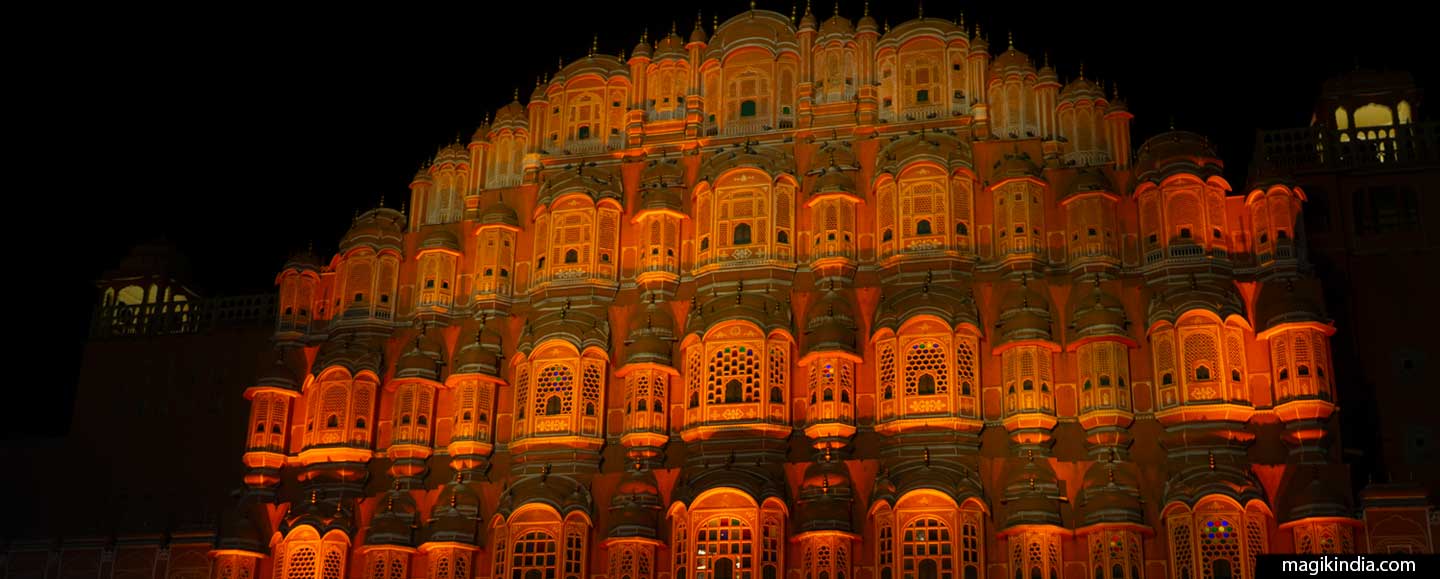
Jaipur, the pink city, capital of Rajasthan
Designed according to Vedic concepts, Jaipur, the buzzing capital of Rajasthan is one of the most visited cities in India. Well, the pink city knows how to charm the traveler: colourful festivals, majestic historic buildings and rich craftsmanship. From the “palace of winds” to the “water palace”, the pink city has no close rival except neighbouring Amber, the Jaipur Maharajas’ previous capital.
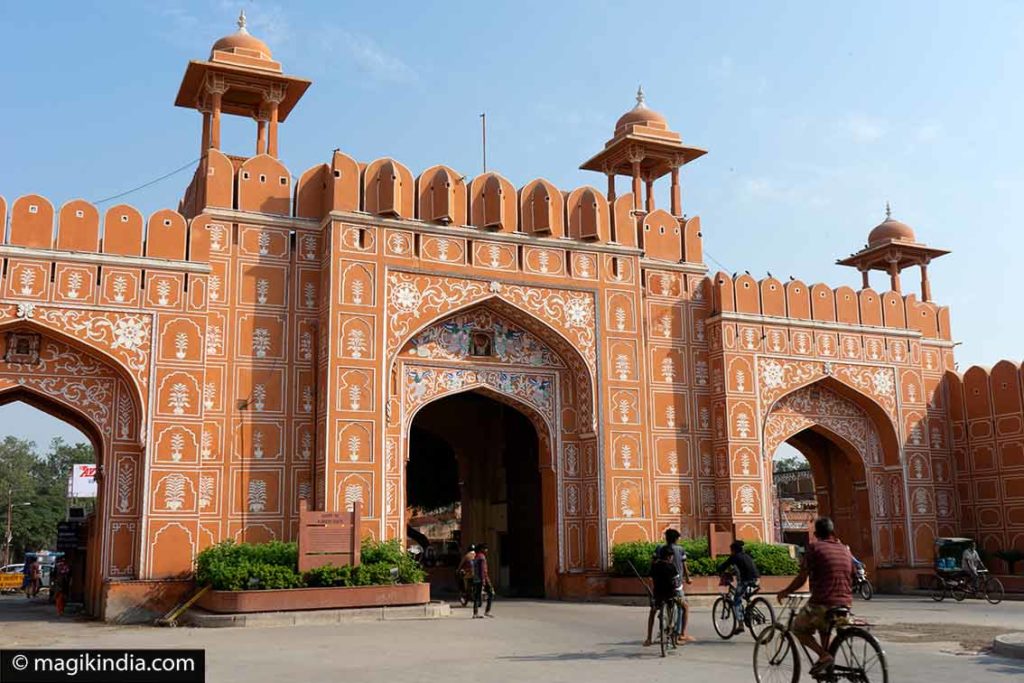
Jaipur is a relatively recent town, built in the 18th century by the Maharaja Jai Singh II. He called in a Bengali town planner who designed the city, in compliance with Vedic concepts, in 9 blocks corresponding to the nine planets of Indian astrology. The entire town is based on a square grid plan. Everything – streets, shops etc. – was standardised from the outset.
Jai Singh’s descendant Ram Singh II had the town repainted in pink to welcome the visiting Prince of Wales in 1876, pink being the traditional colour of welcome. Jaipur has been called the Pink City ever since.
Festivals not to miss
Jaipur Literature Festival

The Jaipur Literature Festival is an annual literary festival taking place in the Indian city of Jaipur since 2006 during the month of January. The Diggi Palace Hotel serves as the main venue of the festival. JLF brings together some of the greatest thinkers and writers from across South Asia and the world. From Nobel laureates to local language writers. jaipurliteraturefestival.org
Elephant Festival
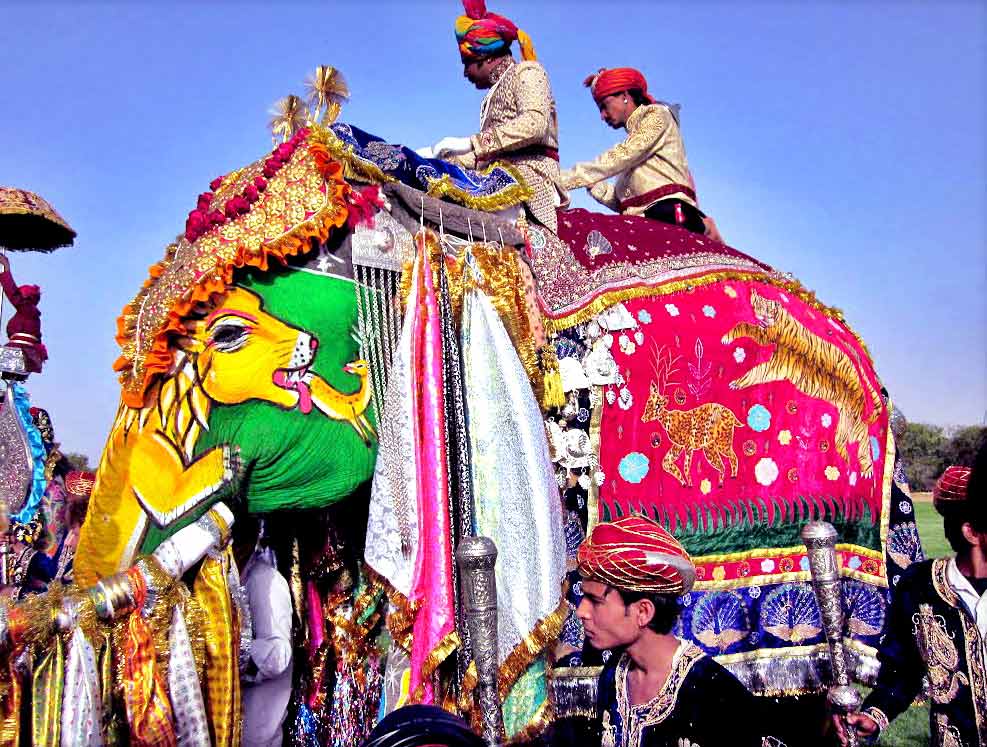
The Elephant Festival is held on the day of Holi festival, usually in the month of March. The festival features Elephant polo and Elephant Dance. The Elephant Festival begins with a beautiful procession of bedecked elephants, camels, horses and folk dancers. The owners proudly embellish their elephants with vibrant colors, jhools (saddle cloth) and heavy jewellery.The most beautifully decorated elephant is awarded.
Gangaur
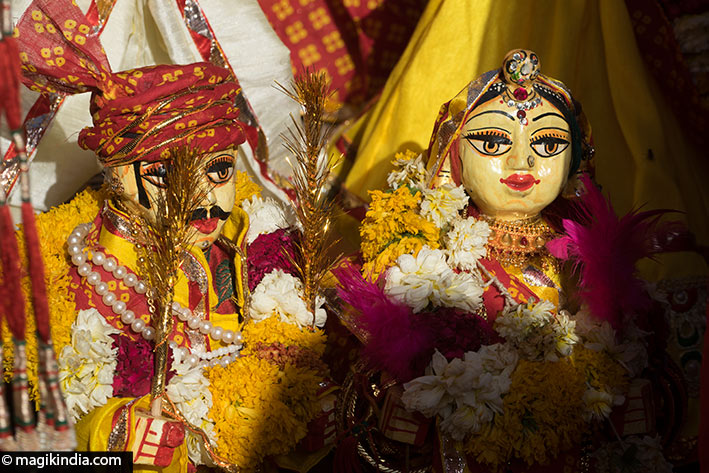 Gangaur is a colourful women’s festival that is mainly celebrated in Rajasthan.The word ‘Gangaur’ is derived from ‘Gana’, a term for Lord Shiva, and ‘Gauri’, referring to his consort Parvati. In fact the festival is mainly in honour of Gauri, symbolising conjugal happiness…
Gangaur is a colourful women’s festival that is mainly celebrated in Rajasthan.The word ‘Gangaur’ is derived from ‘Gana’, a term for Lord Shiva, and ‘Gauri’, referring to his consort Parvati. In fact the festival is mainly in honour of Gauri, symbolising conjugal happiness…
Rajasthan Day
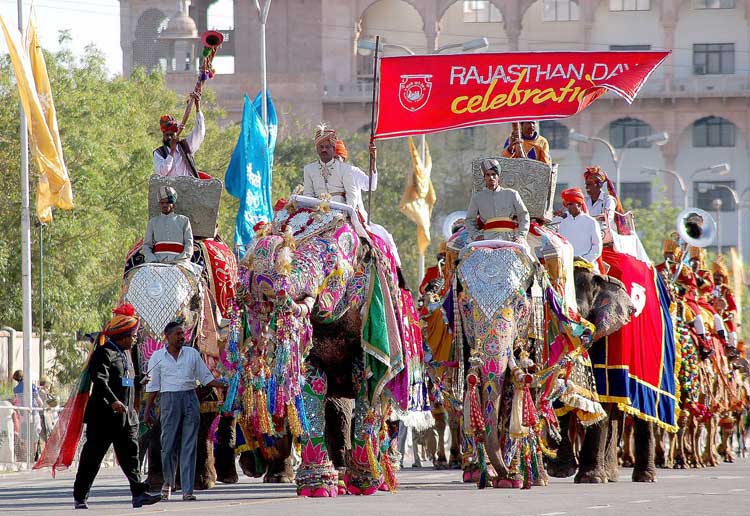
Rajasthan Day is celebrated on 30th March every year with lot of enthusiasm and many exciting and colourful events. These include cultural, classical and theatre events. Rajasthan was formed on 30 March 1949. In significance of this and to make people of Rajasthan have a sense of pride in their state, this day is celebrated as a week long festival.
And now, let’s visit Jaipur !
City Palace
We start the visit of Jaipur by the palace of the city, which occupies the ninth Vedic square, in the center of the city. Maharaja Sawai Jai Singh II began its construction when he moved his court from Amber (see below) to Jaipur in 1727.
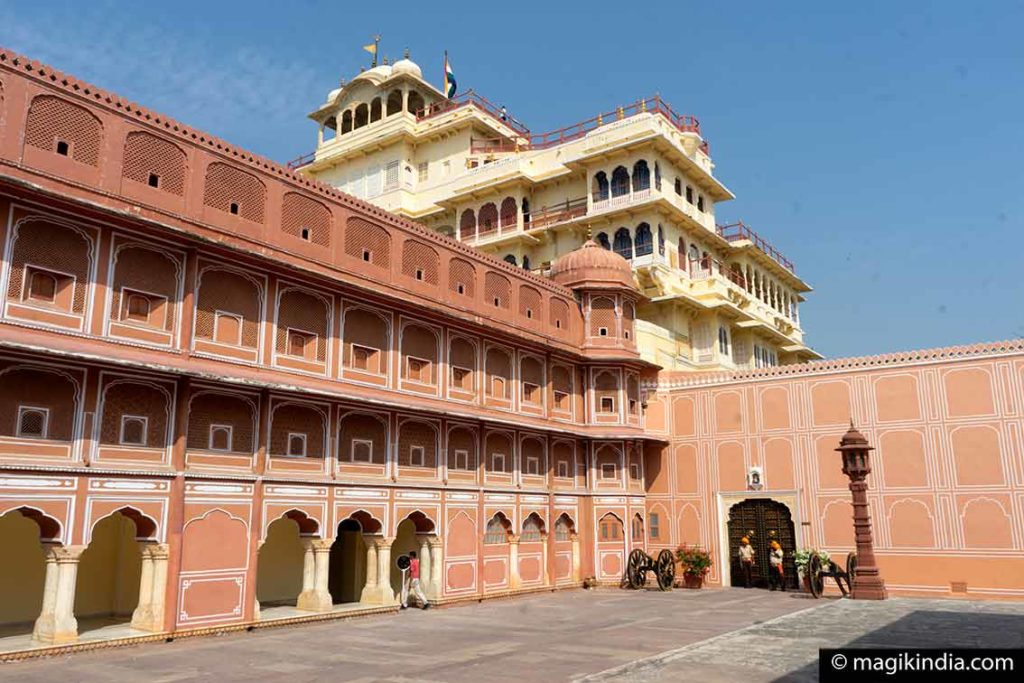
The palace is a complex with several courtyards, palaces, pavilions, gardens and temples.
Upon entering the first courtyard, we come across the Sarvato Bhadra, one of the most famous buildings in the city palace which used to be the ‘Diwan-e-Khas’, or private courtroom.
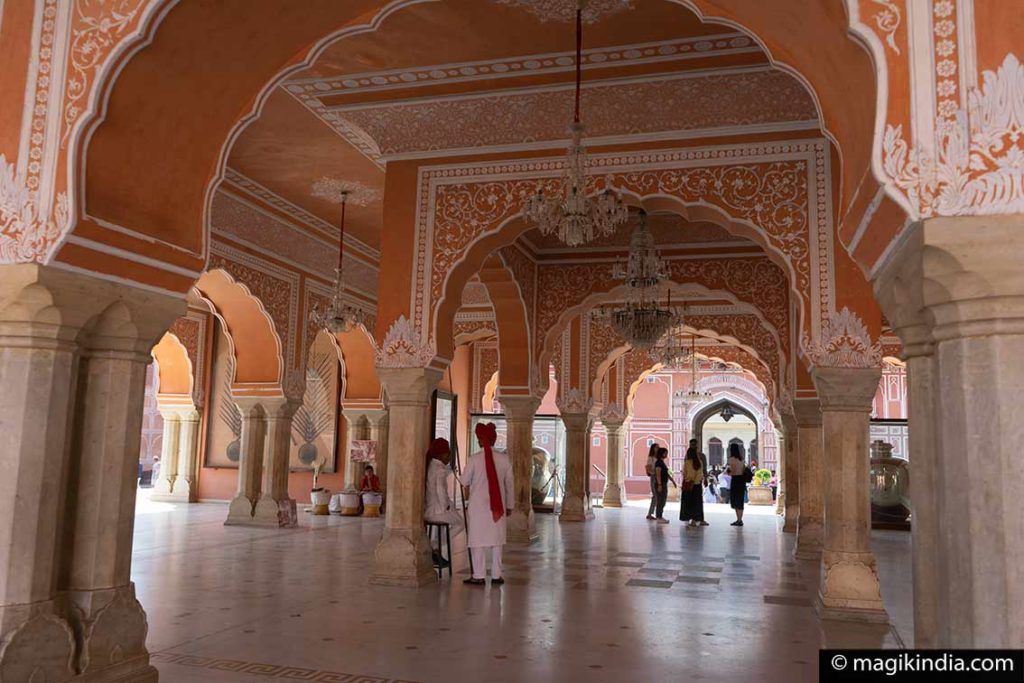
Today, this large square hall continues to be used for celebrations of major Indian festivals such as Dussehra or Makar Sankranti, but also during typical Rajasthani festivities such as Gangaur and Teej, where the idol of the goddess Gauri is placed in a palanquin in the center of the hall, before being carried in a procession around the city.
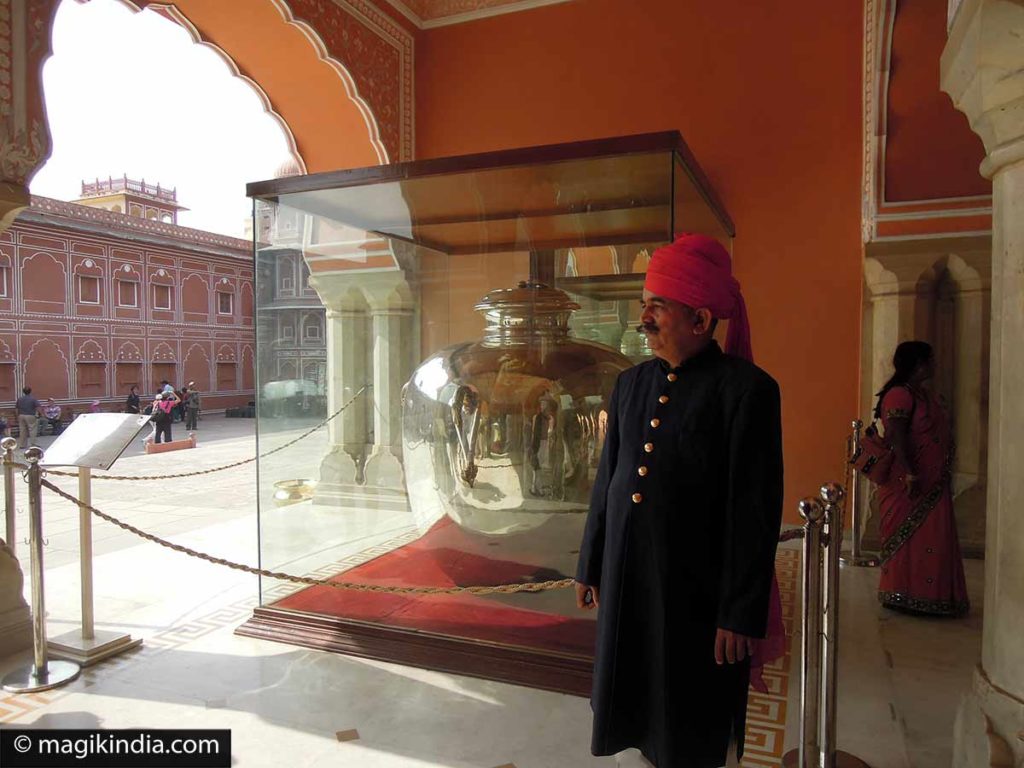
Little megalomaniac anecdote: in the Sarvato Bhadra there are two huge silver jars (Gangajalis) 1.6 meters high, each with a capacity of 4000 liters. They were specially commissioned by Maharaja Sawai Madho Singh II to transport water from the Ganges that was used as drinking water during his trip to England in 1901 in order to attend the coronation of Edward VII. These 340 kg jars are registered in the Guinness book as the largest silver vessels in the world.
To the right of Sarvato Bhadra, a wooden door, where two men in traditional dress stand guard, leads us to the Chandra Mahal, one of the oldest buildings in the complex, still occupied by the current Maharaja and his family.
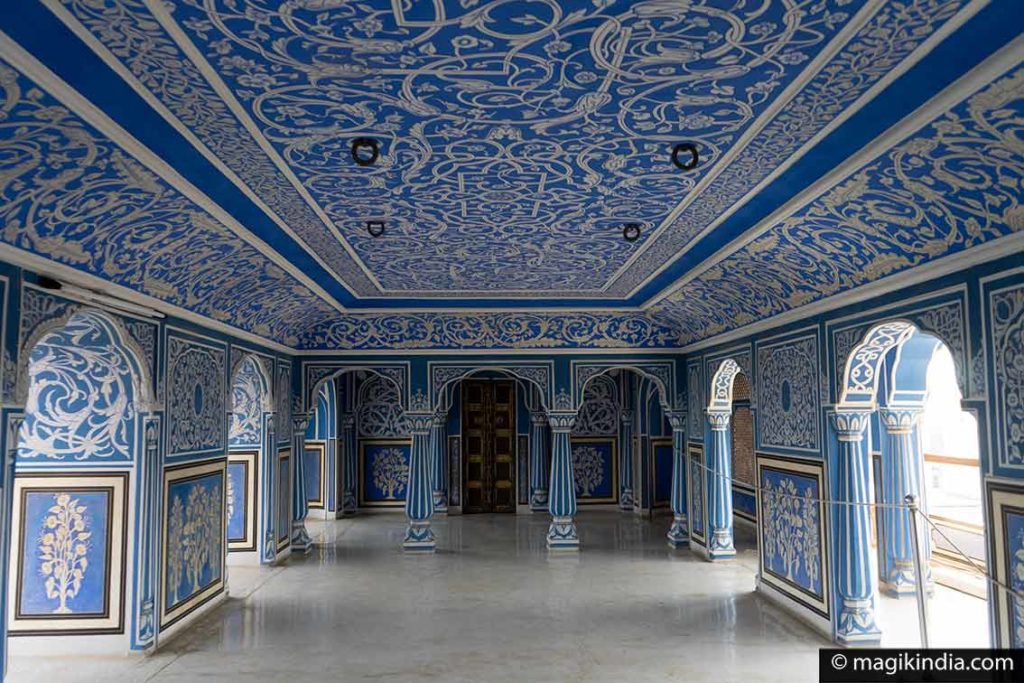
The first two floors include the Sukh Niwas with its pretty blue and white arabesques, followed by Rang Mandir and Shobha Niwas which both have a breathtaking decoration incorporating thousands of mirrors.

The top floors (not accessible to visitors) there are the Shri Niwas and the Mukut Mandir, the coronation pavilion. It is on the Mukut Mandir that the royal standard of Jaipur is hoisted when the Maharaja is in residence.
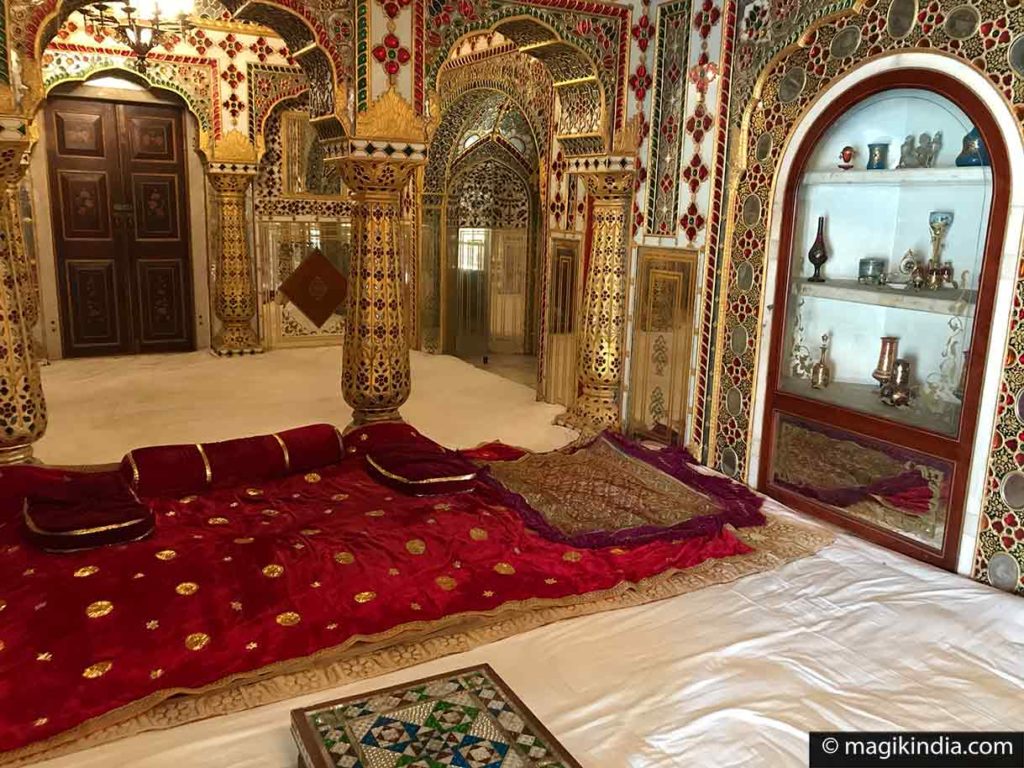
Coming down from Chandra Mahal by narrow internal stairs, we come across the small courtyard ‘Pitam Niwas chowk’ decorated with four magnificent colorful doors representing the four seasons and the Hindu gods associated with them.
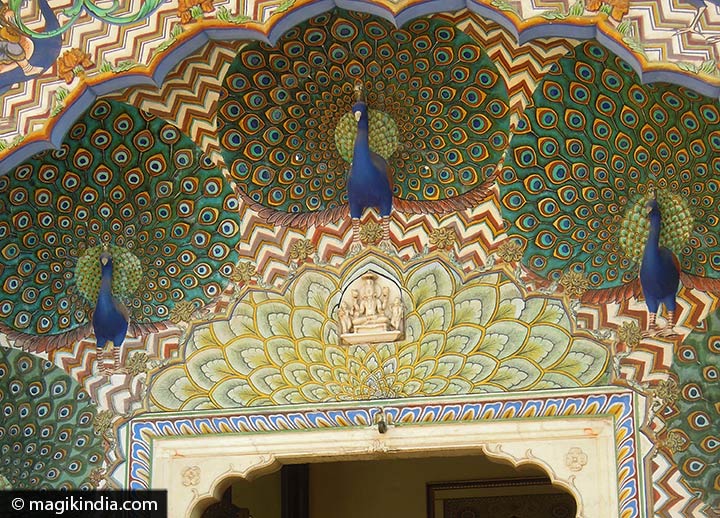
Yantra Mandir ou Jantar Mantar
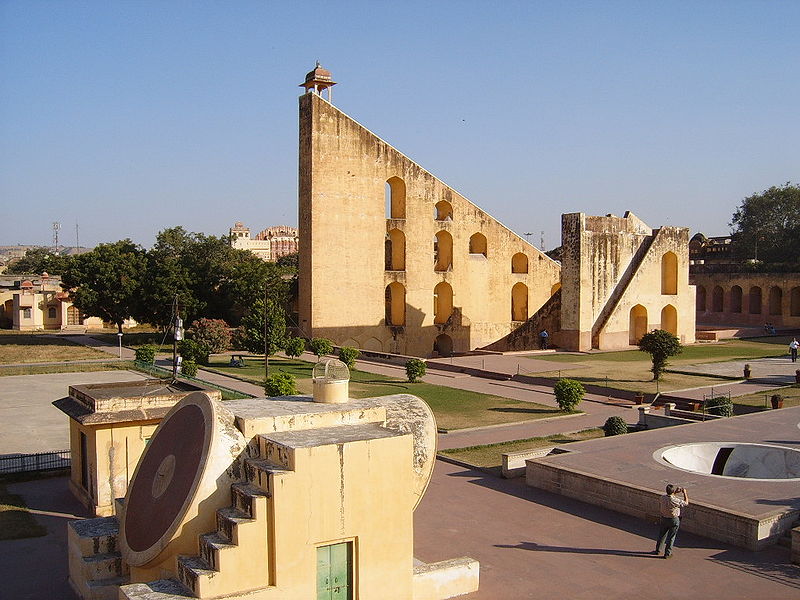
On the right, leaving the City Palace, there is the Jantar Mantar, one of the five observatories of India together with Delhi, Varanasi, Mathura and Ujjain. It is considered as one of the largest and best preserved observatories. It was built by Sawai Jai Singh II in the year of 1724.
The monument features masonry, stone and brass instruments that were built using astronomy and instrument design principles of ancient Hindu Sanskrit texts. The instruments allow the observation of astronomical positions with the naked eye.
Govind Devji Temple
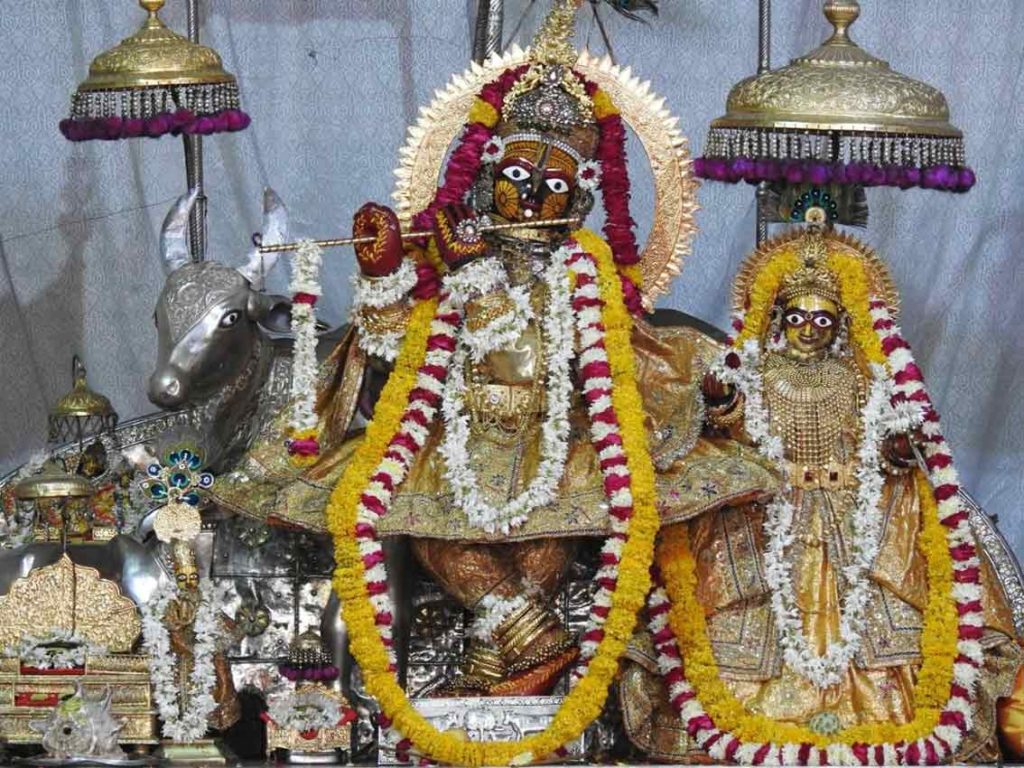
The Hindu temple Govind Dev Ji is located in the City Palace complex and is dedicated to Krishna. The idol was brought back from Vrindavan by Raja Sawai Jai Singh II, the founder of Jaipur. She was also the main deity of the Kachawaha dynasty of Amber.
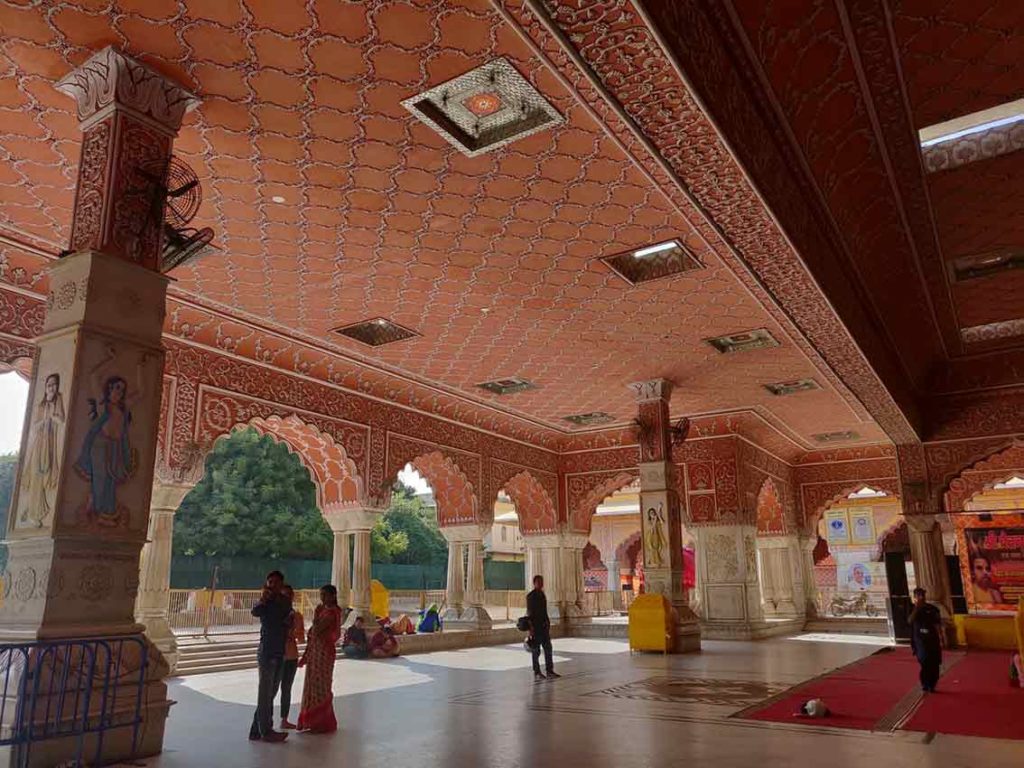
To really immerse yourself in the atmosphere of the Govind Dev Ji temple, visit it during the aratis (see timetables below) and mingle with the crowd of the faithful who make long circumambulations around the altar … A unforgettable experience ! The temple is also worth a visit during the Holi festival, which originated in the history of Lord Krishna.
The schedules of the daily aratis (rituals) of the temple:
| Mangla | 4:45 – 5:15 | |
| Dhoop | 7:45 – 9:00 | |
| Shringar | 9:30 – 10:15 | |
| Rajbhog | 11:00 – 11:30 | |
| Gwal | 17:30 -18:00 | |
| Sandhya | 18:30 – 19:45 | |
| Shayan | 20:45 – 21:15 |
Hawa Mahal (Wind Palace)
The Wind Palace is probably the most emblematic monument of Jaipur which, although located away, is part of the ‘City Palace’ complex; a secret passage also connects the two buildings.
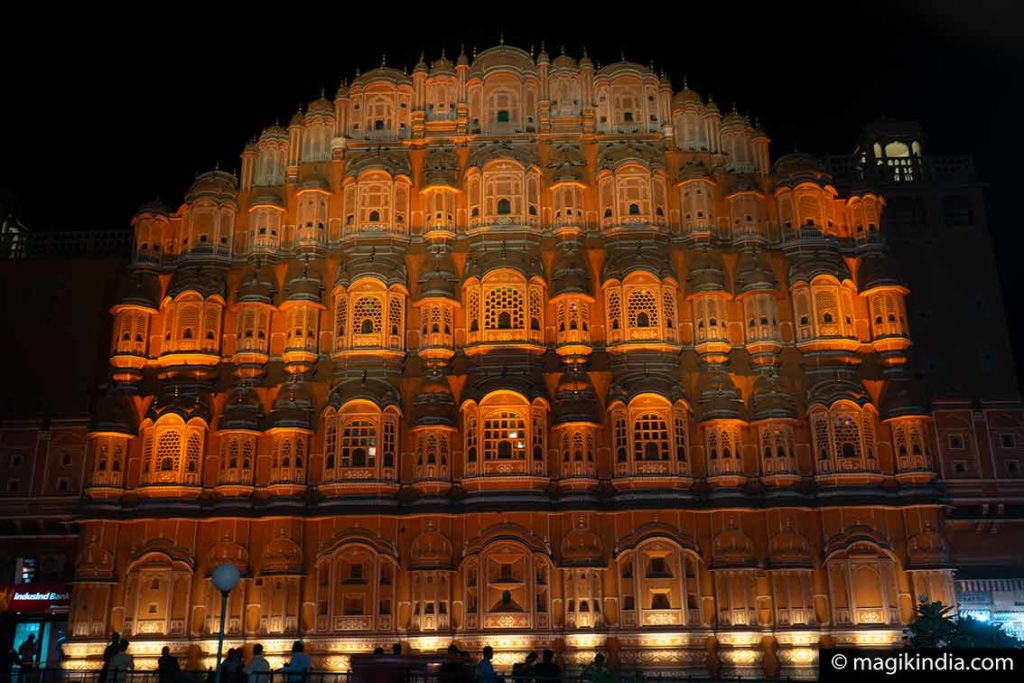
The Hawa Mahal was intended for women of the court (zenana) who could observe, without being seen, the religious processions, through latticed windows.
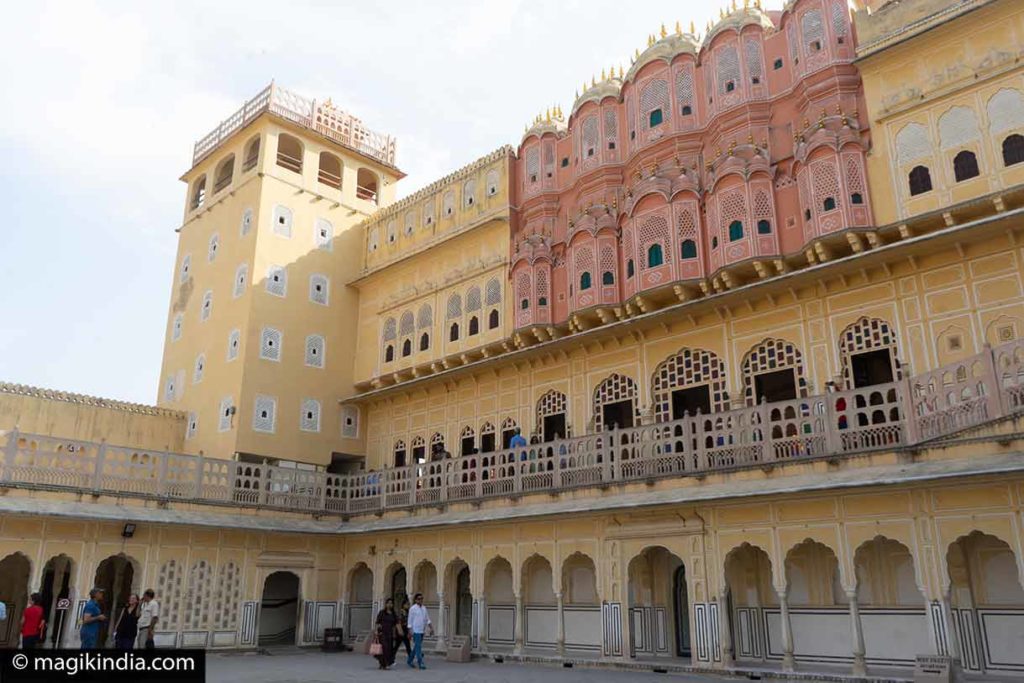
The building was constructed by Maharaja Sawai Pratap Singh in 1799 under the supervision of architect Lal Chandra Usta. The Maharaja being a devotee of Lord Krishna, he asked that the building be constructed in the shape of the crown of Krishna.
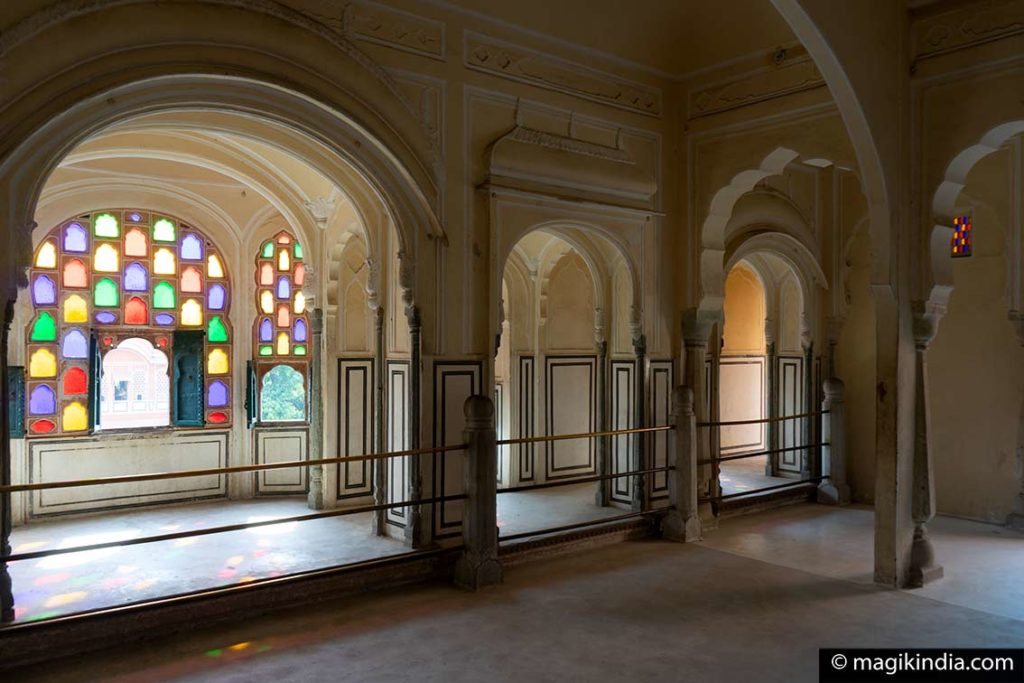
This 5-storey building, comprising 61 stone loggias and 350 windows, was also designed so that the breeze could circulate freely through the many balconies, refreshing the atmosphere – whence its name, which literally means “palace of winds”.
Visit the Hawa palace during the evening too when the Hawa Mahal is particularly is embellished with the lighting.
Minaret ‘Iswari Minar Swarga Sal’
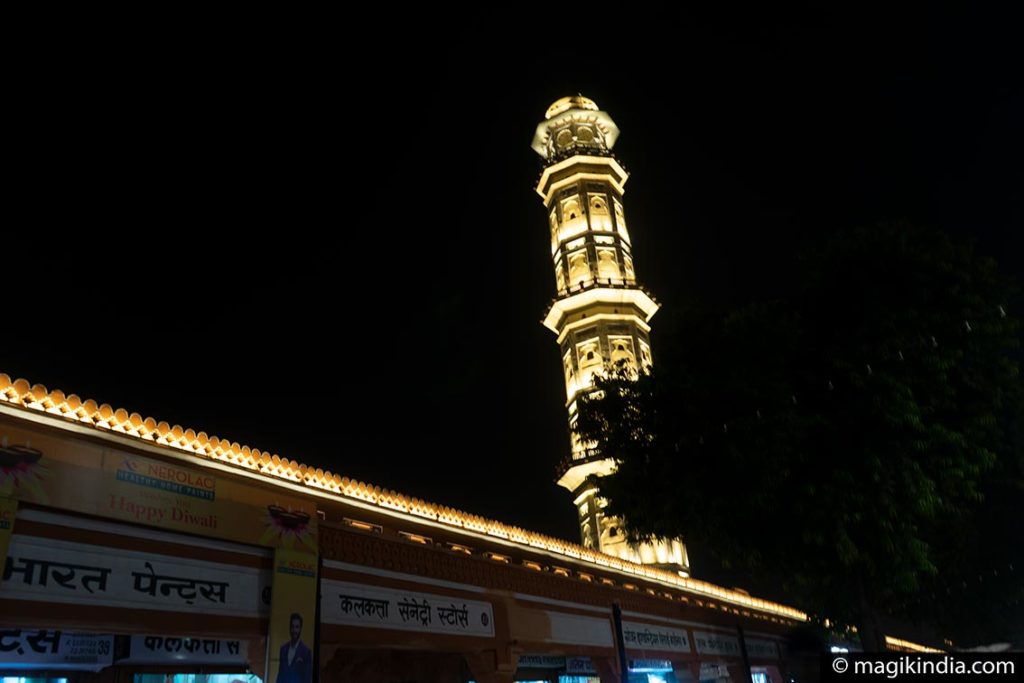
If you want a 360-degree view of the pink city, walk a few more minutes from the Hawa Mahal towards the Tripolia bazaar and climb the steps of the minaret Iswari Minar Swarga Sal, built in the 1740s by Iswari, the son and successor of Jai Singh II. Please note, it closes at 4.30 p.m.
Nahargarh Fort
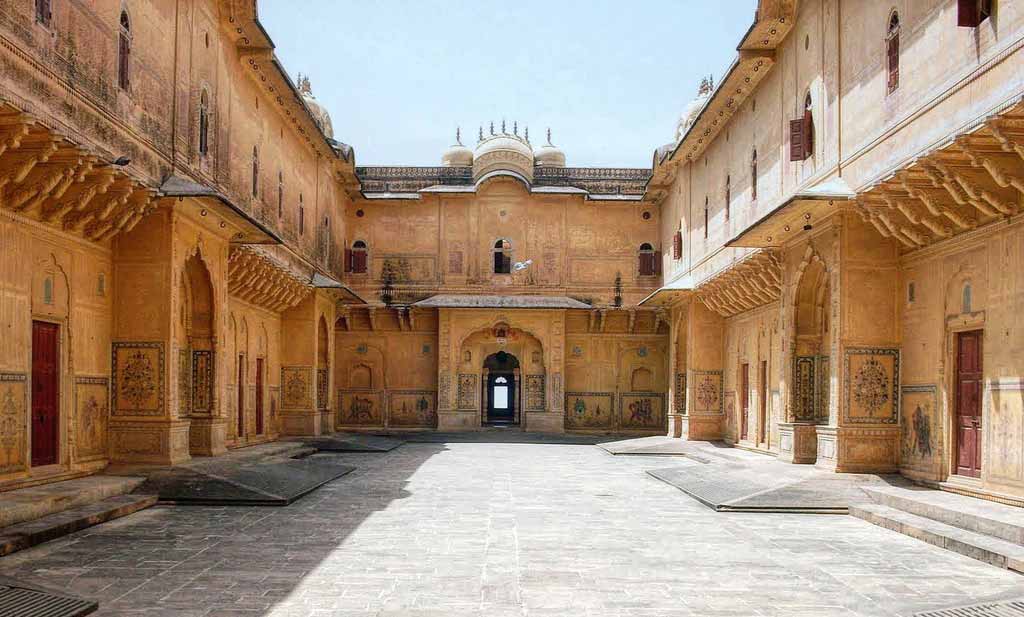
Built in 1734 by Maharaja Sawai Jai Singh II, founder of Jaipur, Nahargarh (“abode of tigers”) stands proudly on the edge of the Aravalli hills above the pink city. Together with Amber and Jaigarh forts, Nahargarh once formed a strong defensive ring for Jaipur.
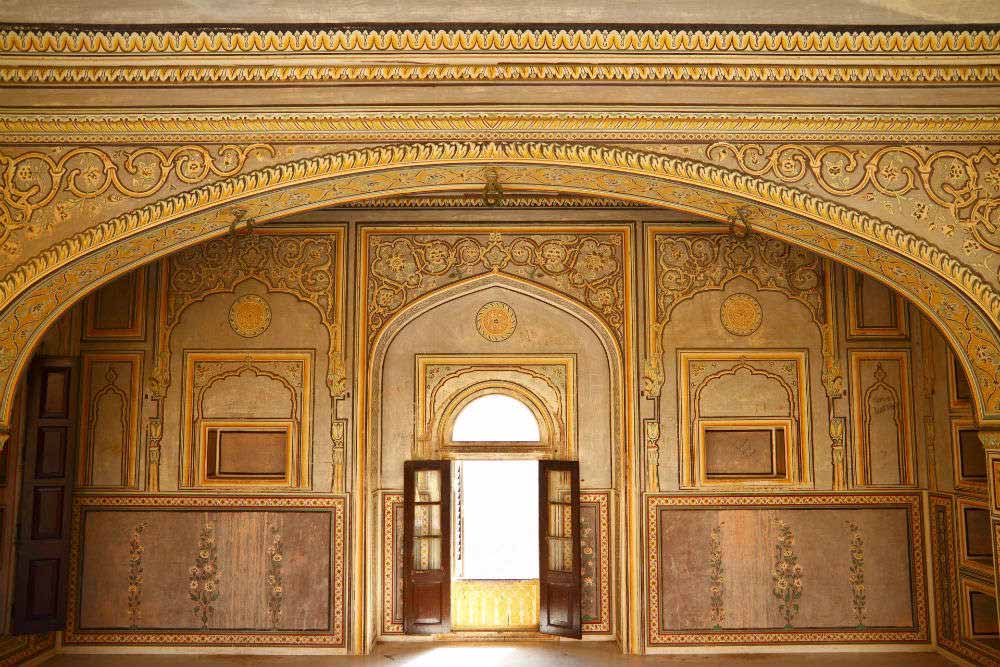
The fort houses the Madhavendra Bhawan, which was the summer destination for members of the royal family. The palace has twelve boudoirs for the queens and a suite for the king. They are all connected by corridors decorated with delicate murals.
Note: Travelers usually visit the fort in the late afternoon to be on time to watch the sunset over the city.
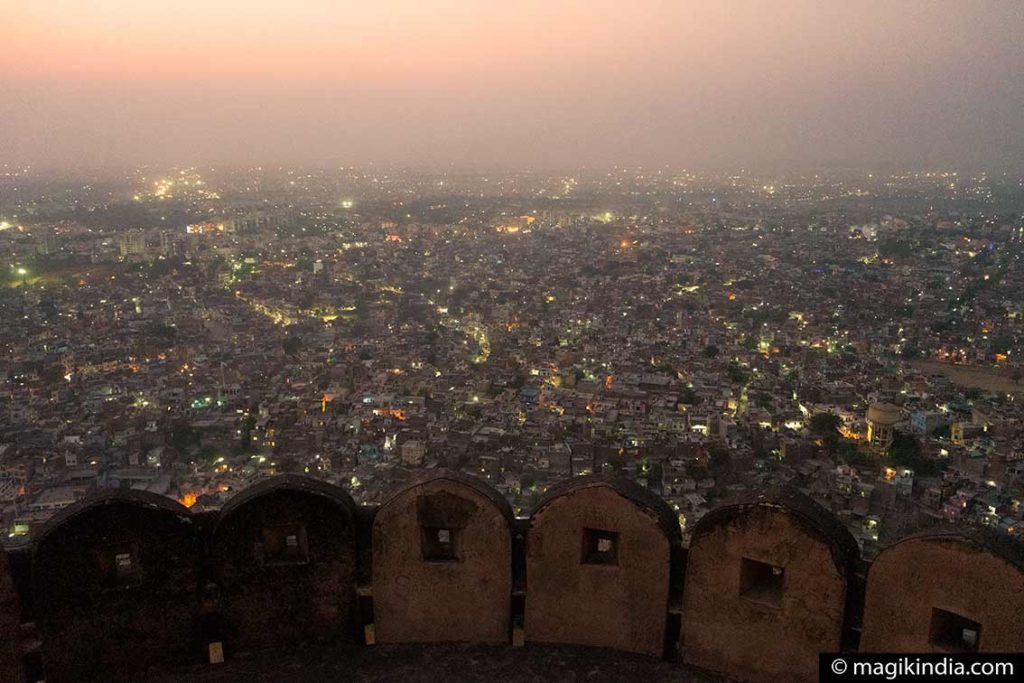
Jal Mahal (Water Palace)
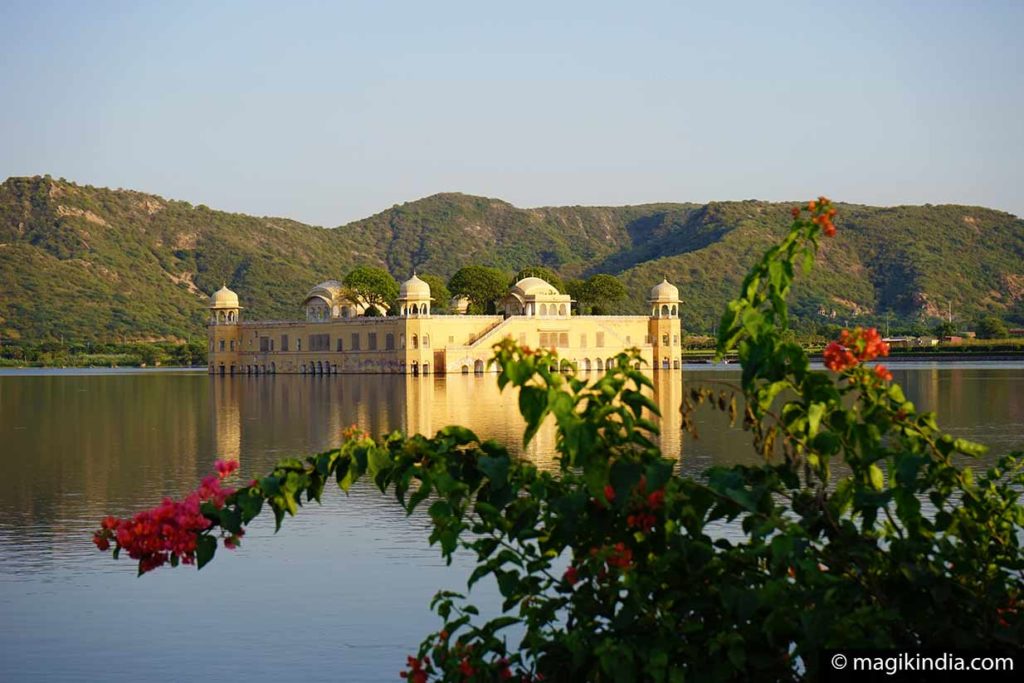
Halfway between Jaipur and Amber stands the romantic Jal Mahal, “floating” in its lake. It was built by Madho Singh in 1799 as a second home for the royal family and also, on a slightly less romantic note, for duck hunting.
Gatore Ki Chhatriyan Cenotaphs
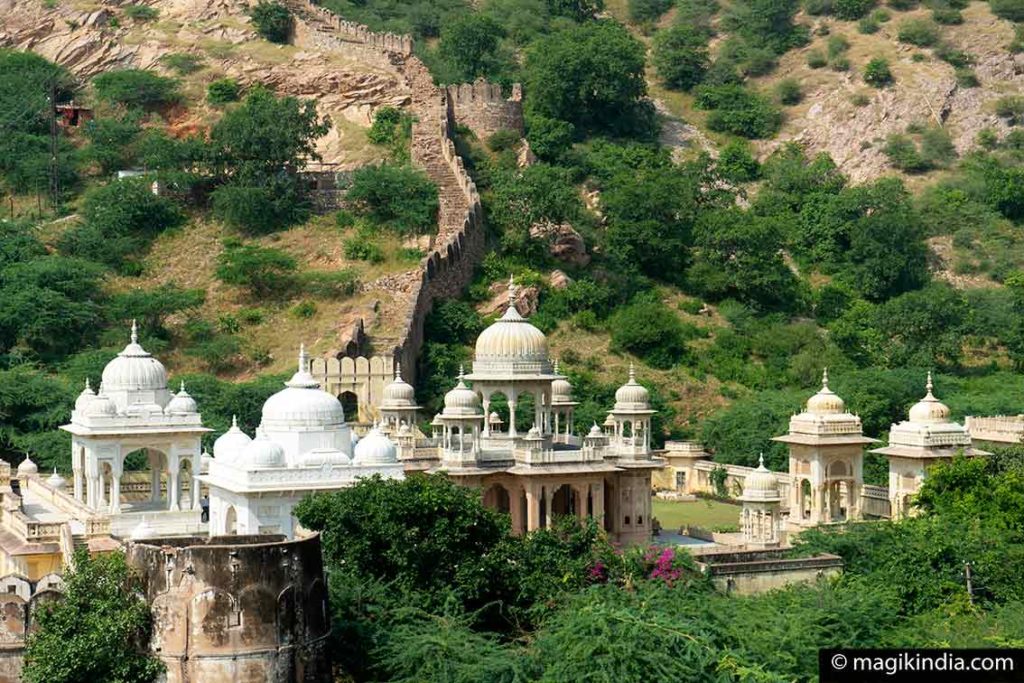
The finely carved and sculpted Gatore Ki Chhatriyan (“last abode of the souls of the dead”), at the foot of the hill, below Nahargarh Fort, is a beautiful complex of temples and cenotaphs of the Rajput Kachwaha dynasty.
The first cenotaph is of Jaipur’s founder, Maharaja Sawai Jai Singh II, and the most recent is of Sawai Raja Man Singh, the father of Maharaja Bhawani Singh, the last king of Jaipur.
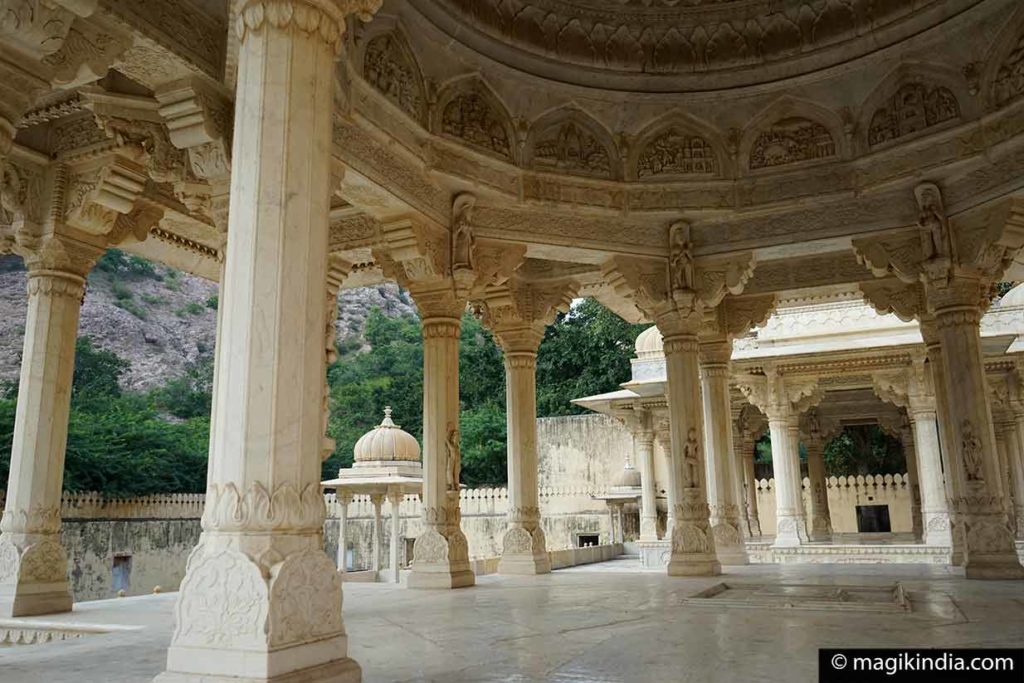
Garh Ganesha Temple
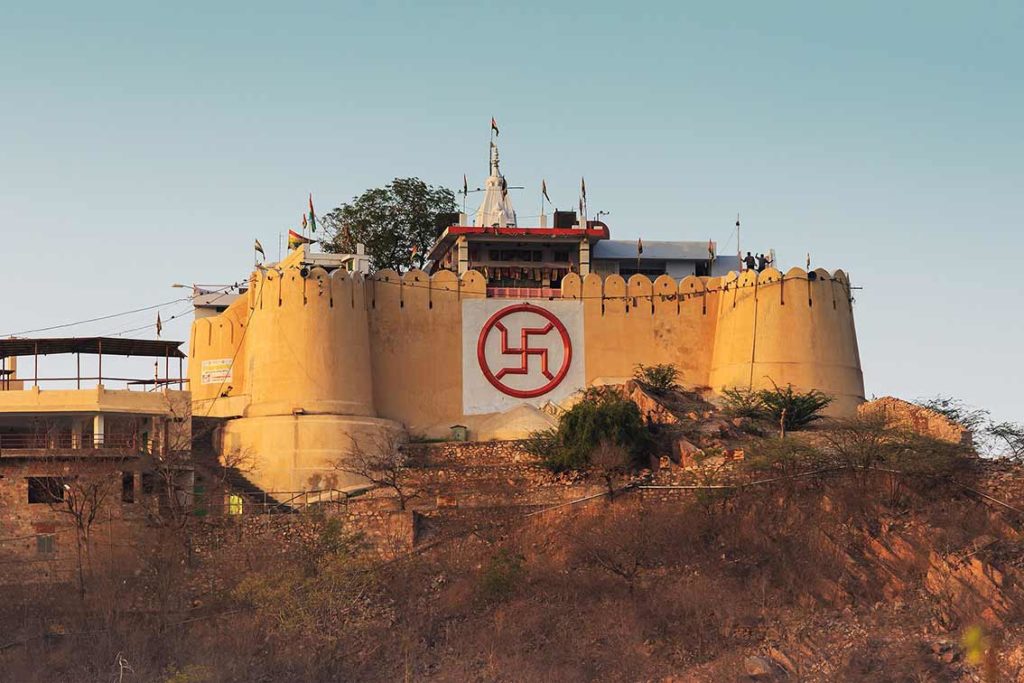
The Garh Ganesha temple is dedicated, as its name suggests, to Ganesha, the elephant-headed god. It is perched on top of one of the Aravalli hills, near that of Fort Nahargarh. It is reached by steep stairs from the royal cenotaphs Gatore Ki Chhatriyan (see above).
The temple was built by Maharaja Sawai Jai Singh when he performed the Ashwamedha Yagna fire ritual before settling in Jaipur. It is said that he placed the statue so that he could see it from the City Palace with binoculars.
To visit preferably in the early morning to avoid the scorching heat and because also, it is customary to start each day with the darshan (sight) of Ganesha, the auspicious god. 🙂
Jaipur by night, a must
The capital of Rajasthan is particularly nice at night when the buildings and monuments are highlighted by judicious lighting. This is the case of the Palace of the Wind (see top of the page), but also of the Albert Hall Museum, the Birla Mandir, the Raj Mandir and the city’s bazaars.
Albert hall Museum
Located outside of the city walls, the Albert Hall Museum is the oldest state museum in Rajasthan. It was designed by the British architect Sir Samuel Swinton Jacob and presents a beautiful Indo-Saracenic architecture, that is to say a mixture of British architecture, Rajasthani and Mughal.
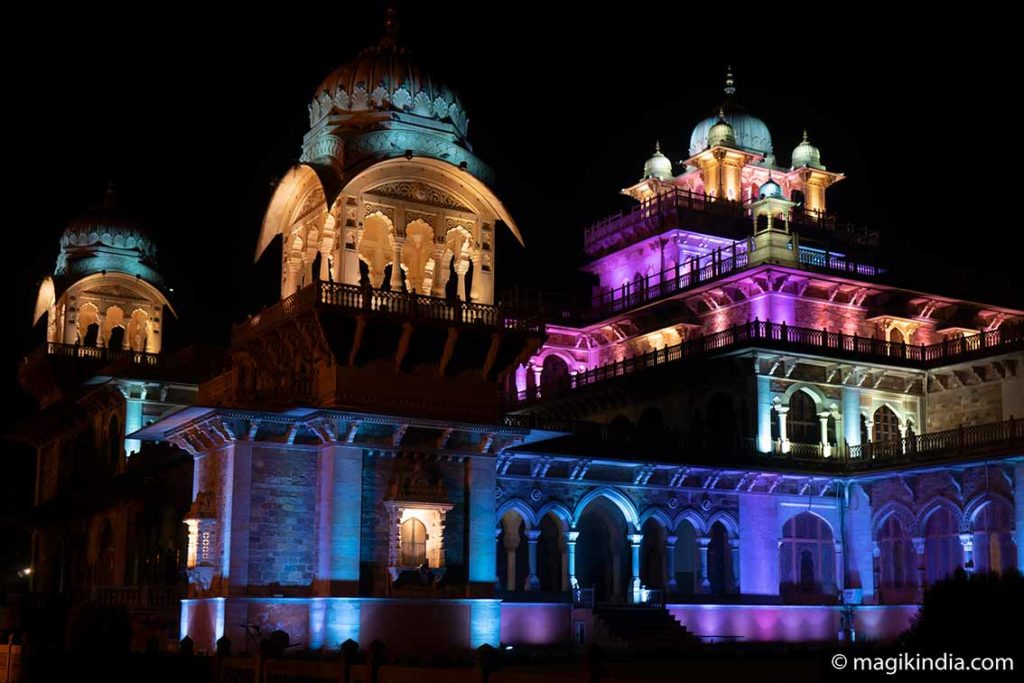
The museum has a rich collection of artifacts, but the star here is an Egyptian mummy, that of a ‘Tutu’, a female member of the family of a priest, dating from the Egyptian Ptolemaic period (322 BC to 30 BC). It was brought back from Cairo in 1887 by the Maharaja of Jaipur, Sawai Ishwar.
Birla Mandir Temple (Laxmi Narayan Mandir)
Birla Mandir is a Hindu temple at the foot of Moti Dungari hill, shortly after the Albert hall Museum. This vast white marble temple was built around 1988 by the Birla family, a wealthy Indian business family.
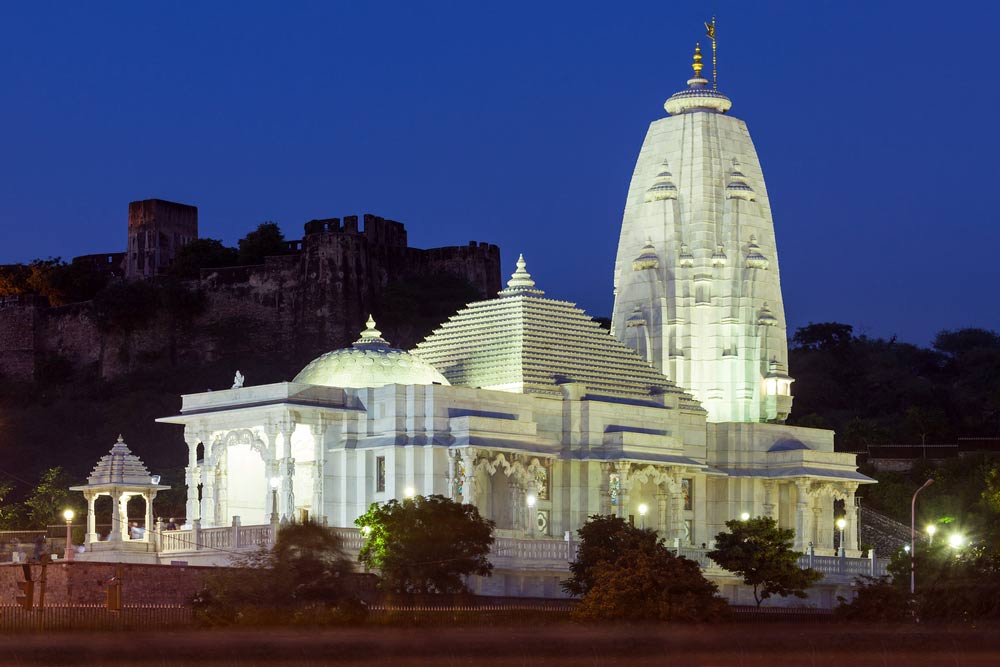
The temple is dedicated to Vishnu and his consort Lakshmi, goddess of prosperity. The deities of the Hindu pantheon are portrayed inside the temple while the exterior is adorned with great figures such as Socrates, Zarathustra, Christ, Buddha and Confucius.
Raj Mandir Theatre
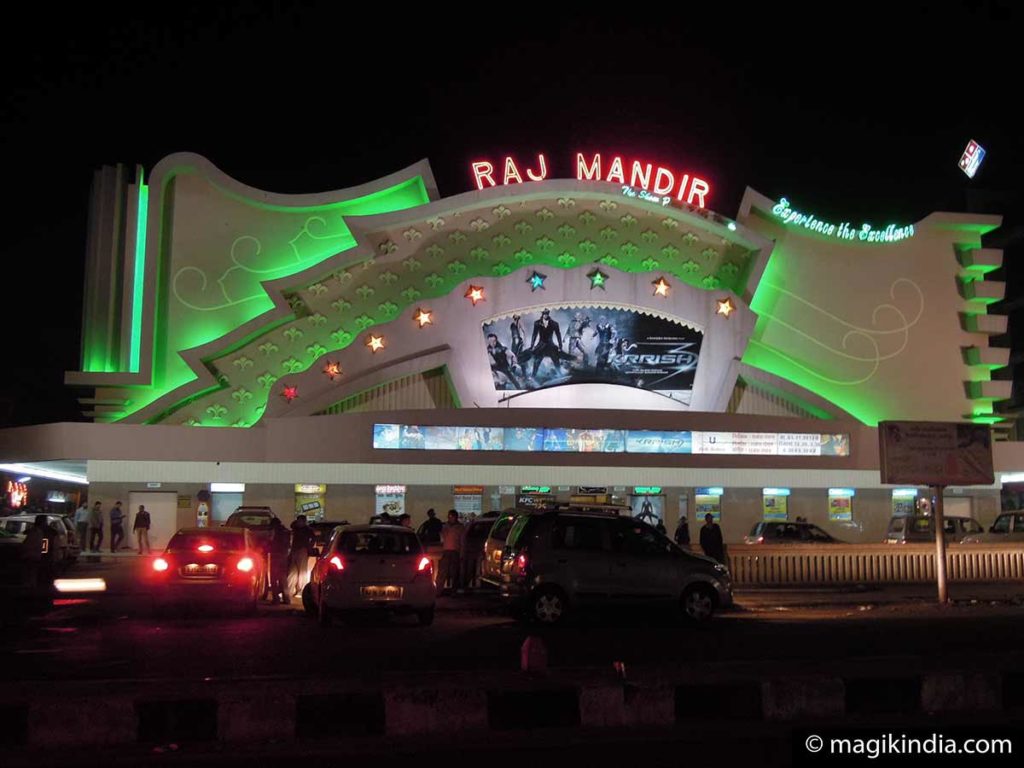
Why not take in a Bollywood* film in Jaipur? Raj Mandir is the place to go for that. It’s one of India’s most famous cinemas. Built in Art Deco style, it opened in 1976. The high-kitsch meringue-shaped auditorium is well worth seeing.
* “Bollywood”, a word made up from “Bombay” and “Hollywood”, is the name for a genre of popular films made in India in the Hindi language.

In any case going to the movies while in India is an unmissable experience. Even without understanding the language, the atmosphere says it all. Indian film fans throw themselves into the experience, sometimes shouting, singing and dancing. You’ll need to set aside three hours for this.
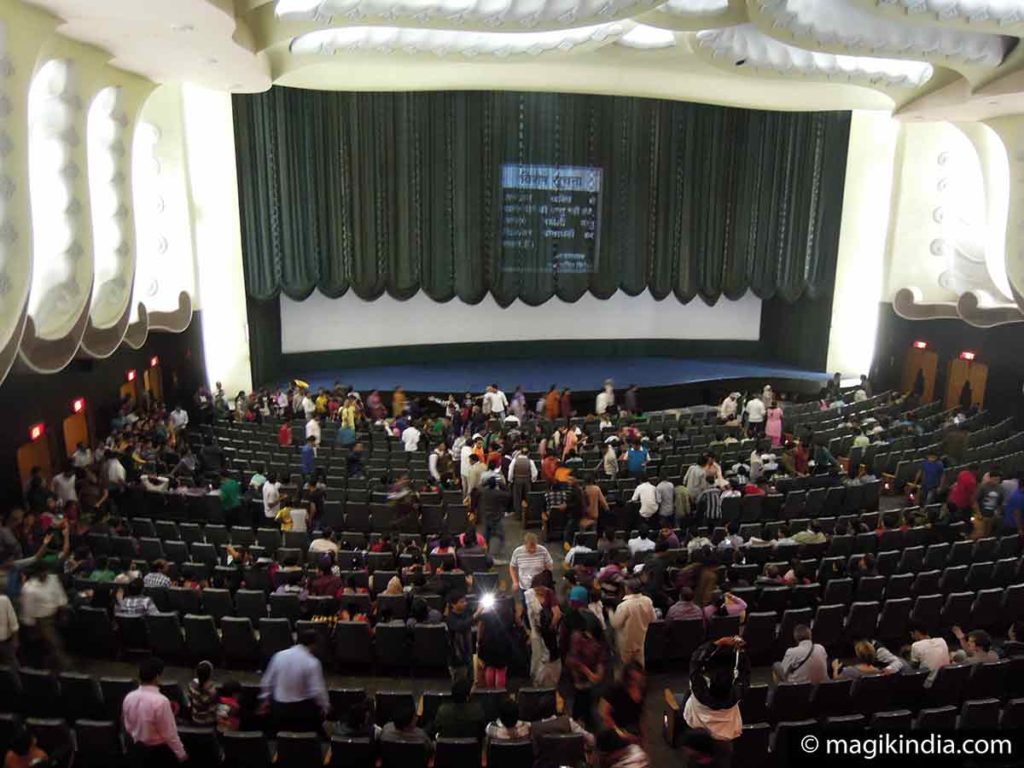
Bazaars of the old town
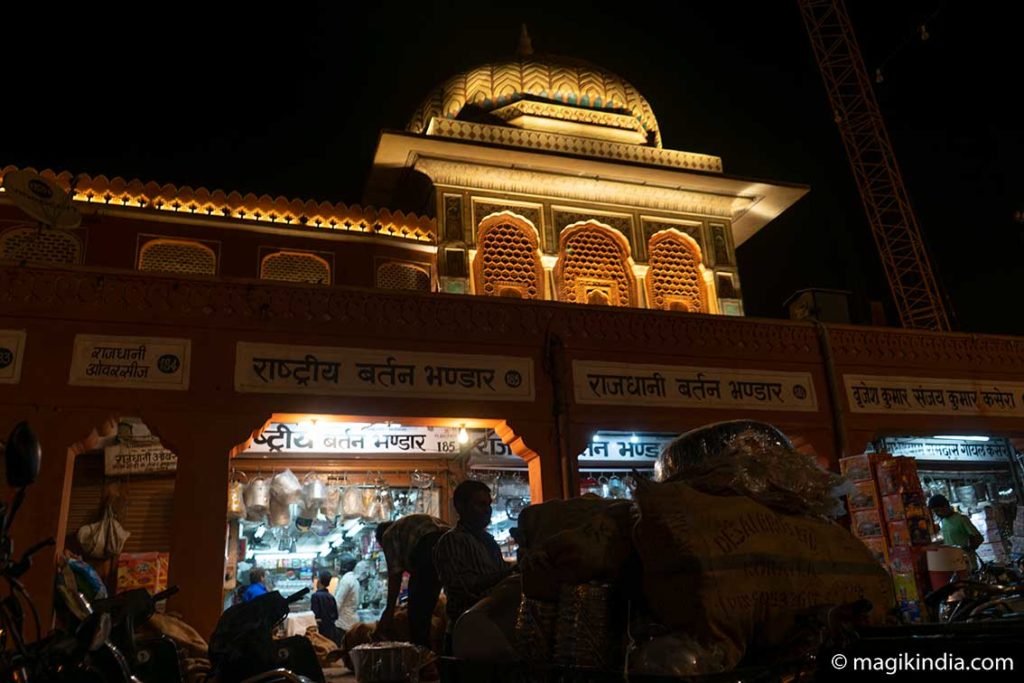
In India, a visit to the bazaars is an experience not to be missed and those of Jaipur are particularly suitable for strolling and shopping. Here, each bazaar has its specialty; The Kishanpole Bazaar specializes in textiles, the Tripolia bazaar in bangles, the Johari bazaar for jewelry, etc.
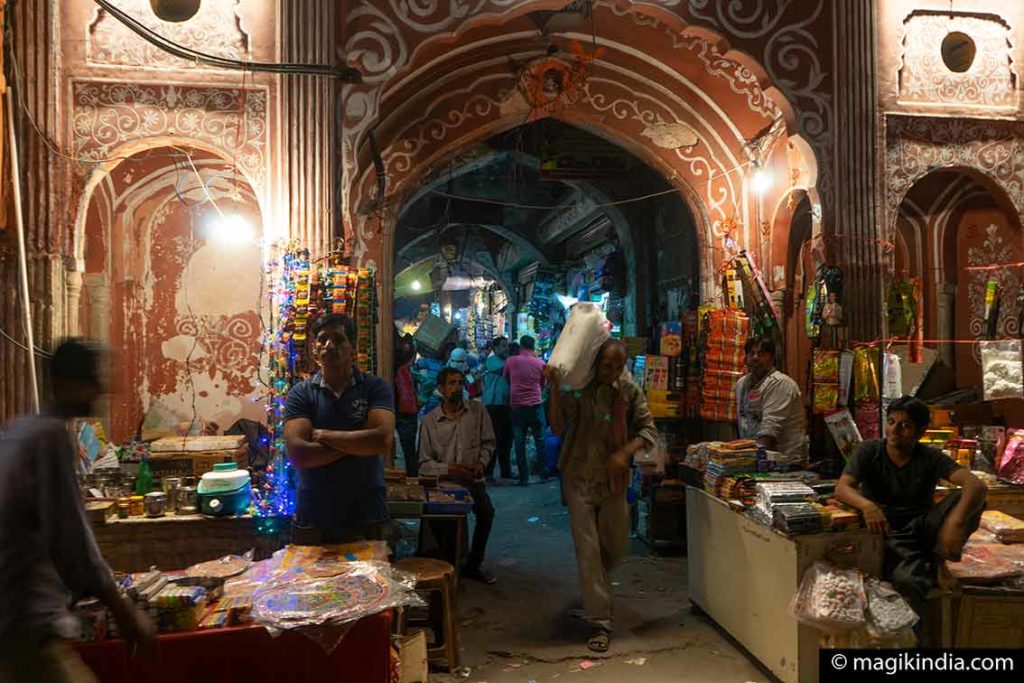
Amber, the former capital (11 km)
Jaipur’s visit is incomplete without that of Amer, also spelled Amber, which is the former capital of the Maharajas of Jaipur. The Amer Palace is the city’s main attraction, but other monuments all around are also worth a visit.
Amber fort
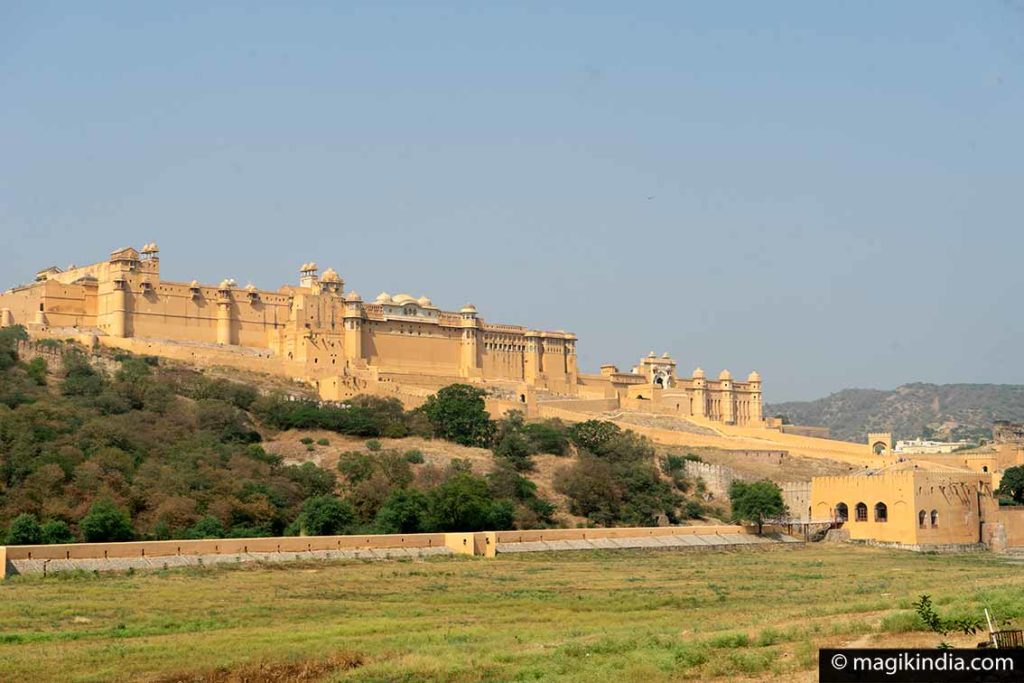
Amber Fort, which also includes a palace, was built in 1592 by Maharaja Man Singh I on the remains of an 11th-century fort. Successive leaders added several structures to the fort before moving the capital to Jaipur in 1727 following an increase in population and because of a water shortage.
We enter the fort through the ‘Suraj Pole’ (door of the sun), which leads to the main courtyard, the Jaleb chowk. It was here that the king’s military parades were held.
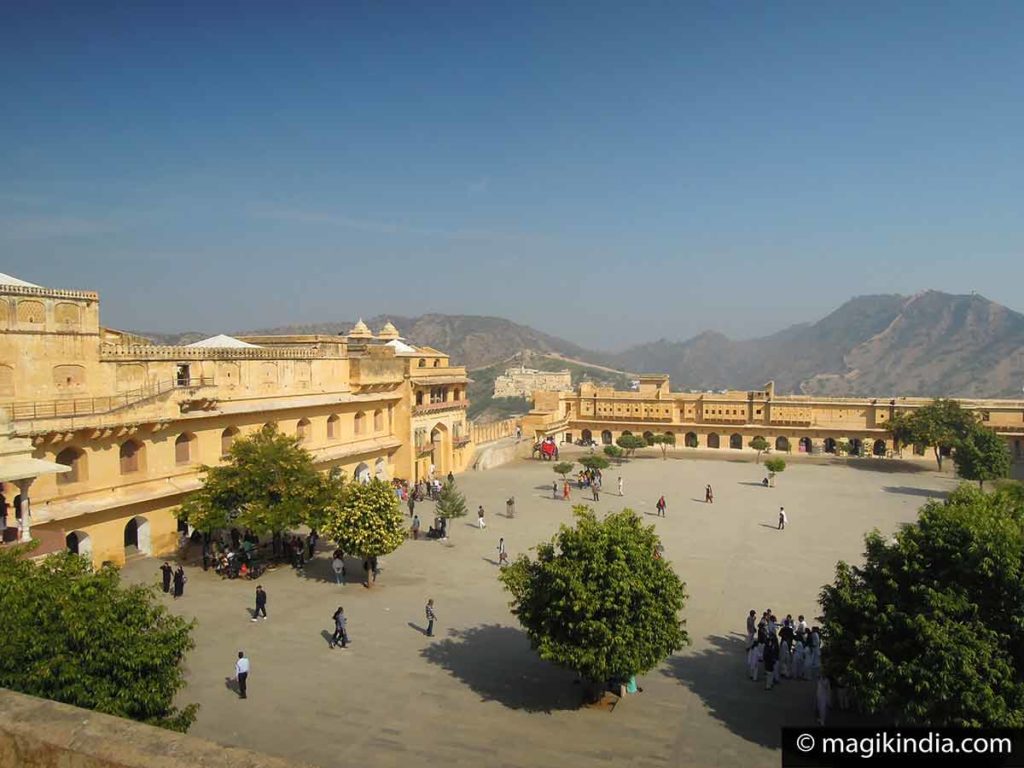
Just to the right in front of this courtyard, stairs lead to the temple dedicated to Shila Devi (a form of the goddess Durga) whose idol was given to Raja Man Singh when he defeated the Raja of Jessore (present-day Bangladesh), in 1604.
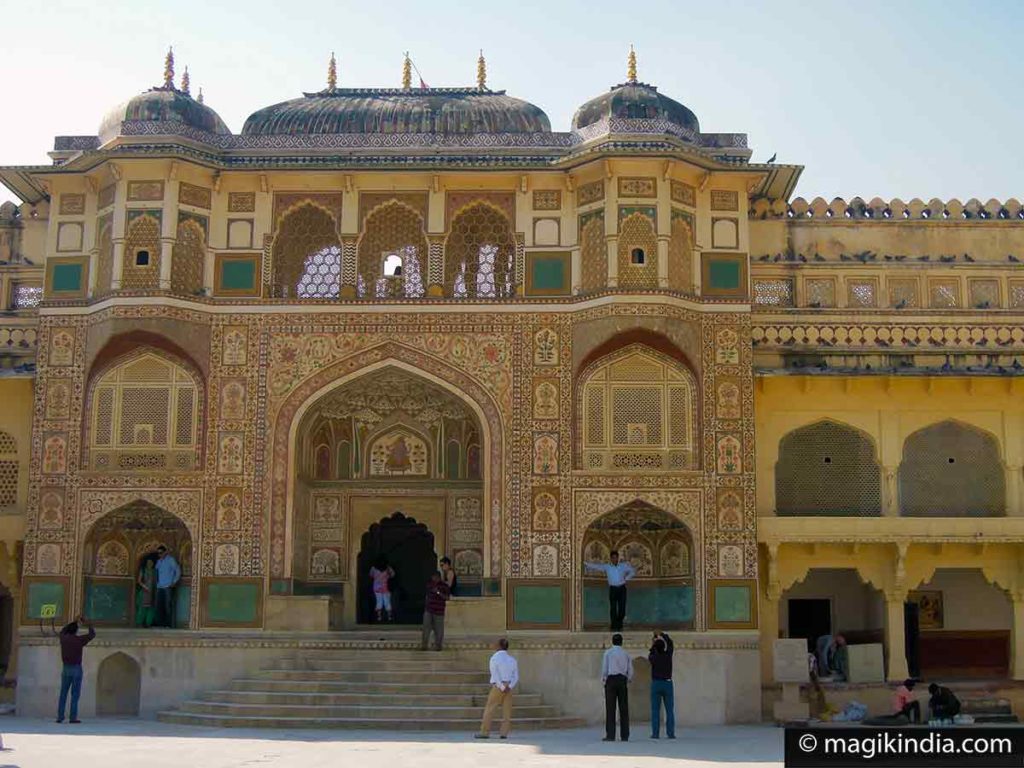
The second courtyard of the fort includes the Diwan-e-Aam (hall of public hearings) erected on an elevated platform with 27 columns.
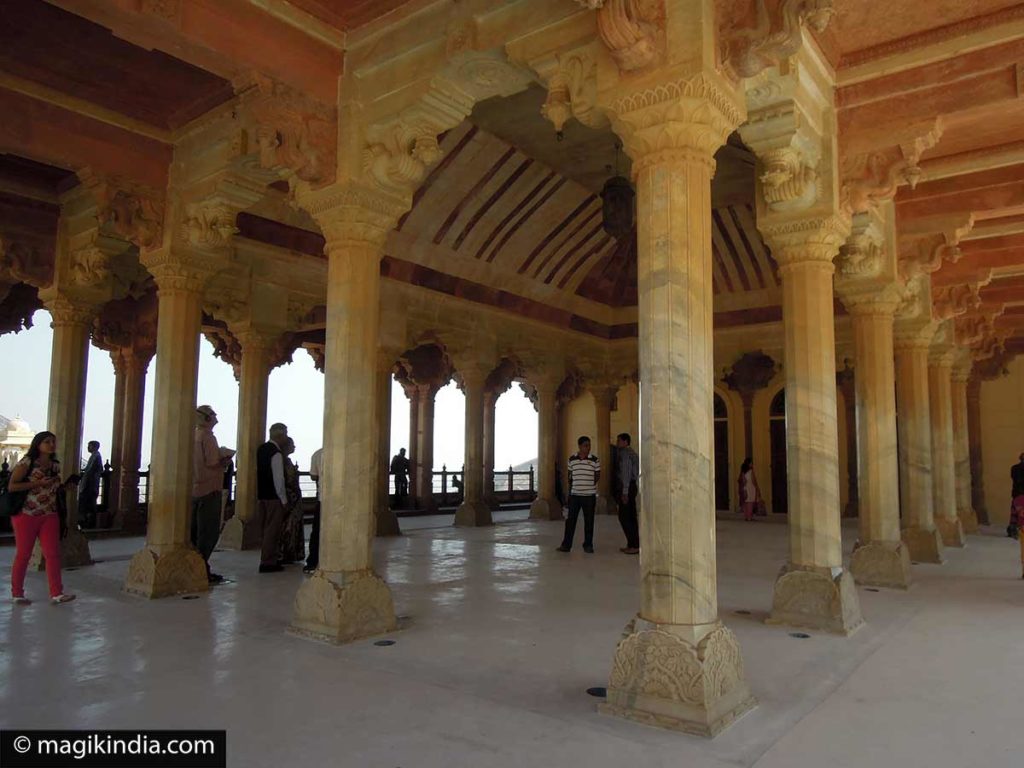
The third courtyard was the private apartments of the Maharaja and his family. It is reached by the beautiful Ganesh porch decorated with miniature paintings. The courtyard consists of two buildings, one opposite the other, separated by a Mughal-style garden.
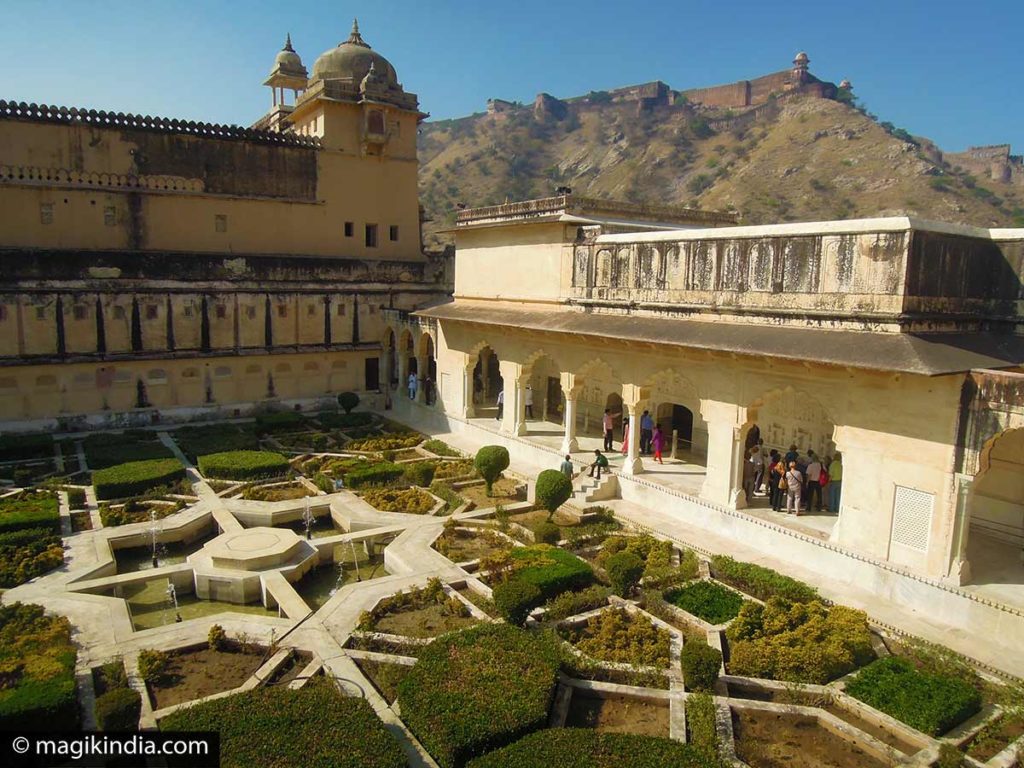
The building to the left of the front door is called the ‘Sheesh Mahal’ (Palace of Mirrors) and for good reason, it is beautifully adorned with inlaid mirrors designed so that they shine under the candle light like a starry sky.
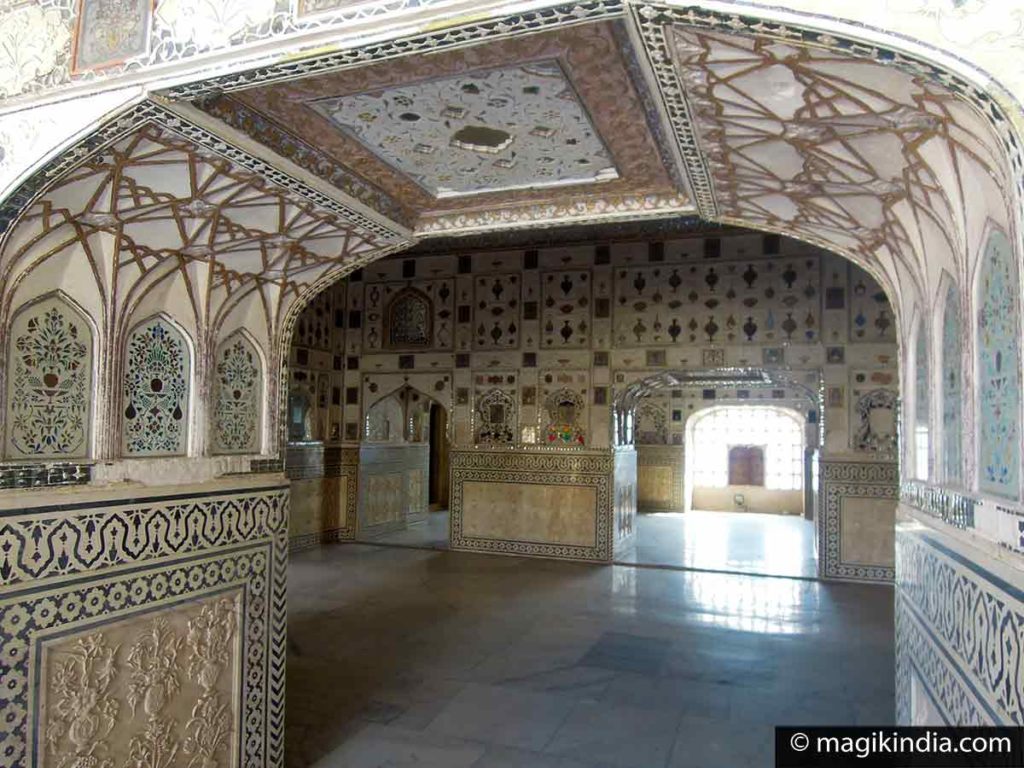
Opposite the mirrors palace is the Sukh Niwas (pleasure hall) whose walls are decorated with marble inlays and niches. An open canal crosses the building to the Mughal garden, which refreshes the atmosphere.
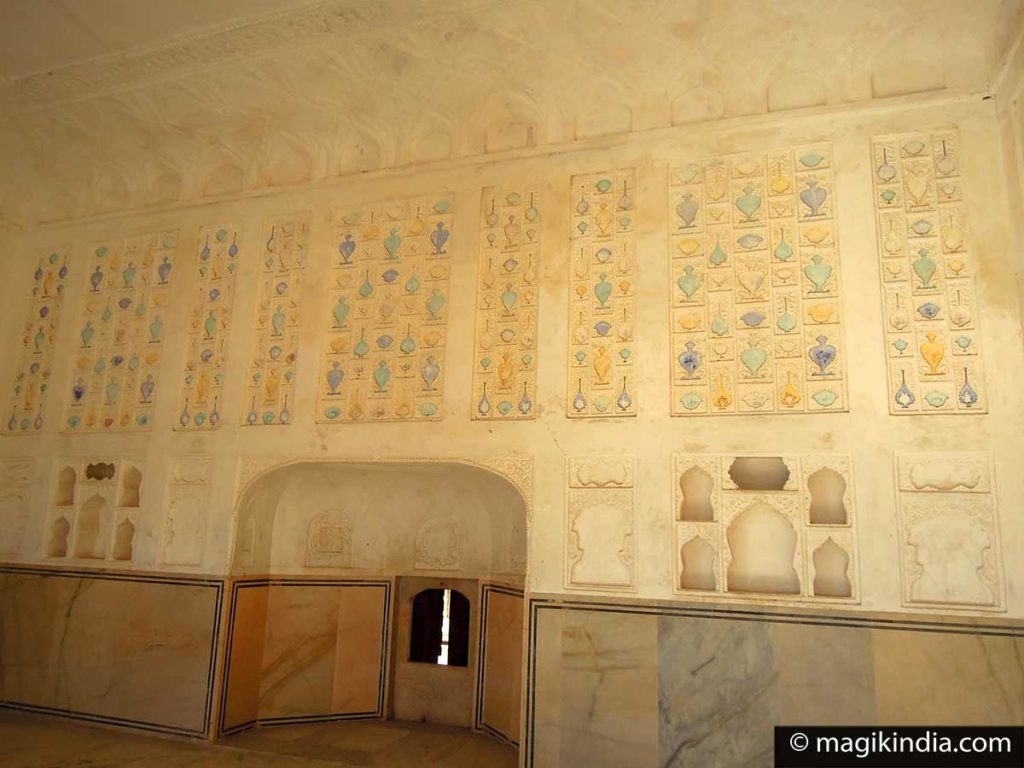
The fourth courtyard is where the Zenana was located, in other words the harem of the maharaja, where not only the women of the royal family lived but also the concubines. This courtyard includes numerous lounges where the women resided awaiting the improvised visit of the Maharaja.
Jaigarh Fort
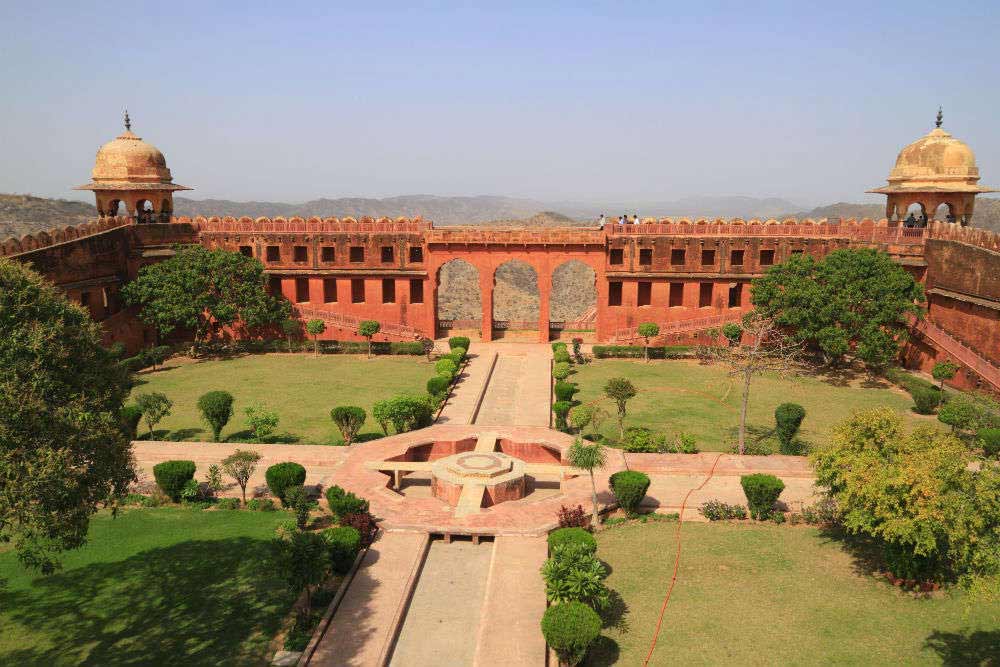
To protect the palace of Amber, Jai Singh II built the fort of Jaigarh (the victory fort) in 1726 on a promontory of the Aravalli mountains called Cheel Ka Teela (the hill of the eagles). It overlooks the Amber Fort by 400 meters and its thick wall of red sandstone stretches for 3 kilometers. The fort includes a palace, gardens and a museum, but its main attraction is the ‘Jai Vana’, one of the largest wheeled cannons in the world. Manufactured around 1720, it has an impressive shooting range of around 30 km.
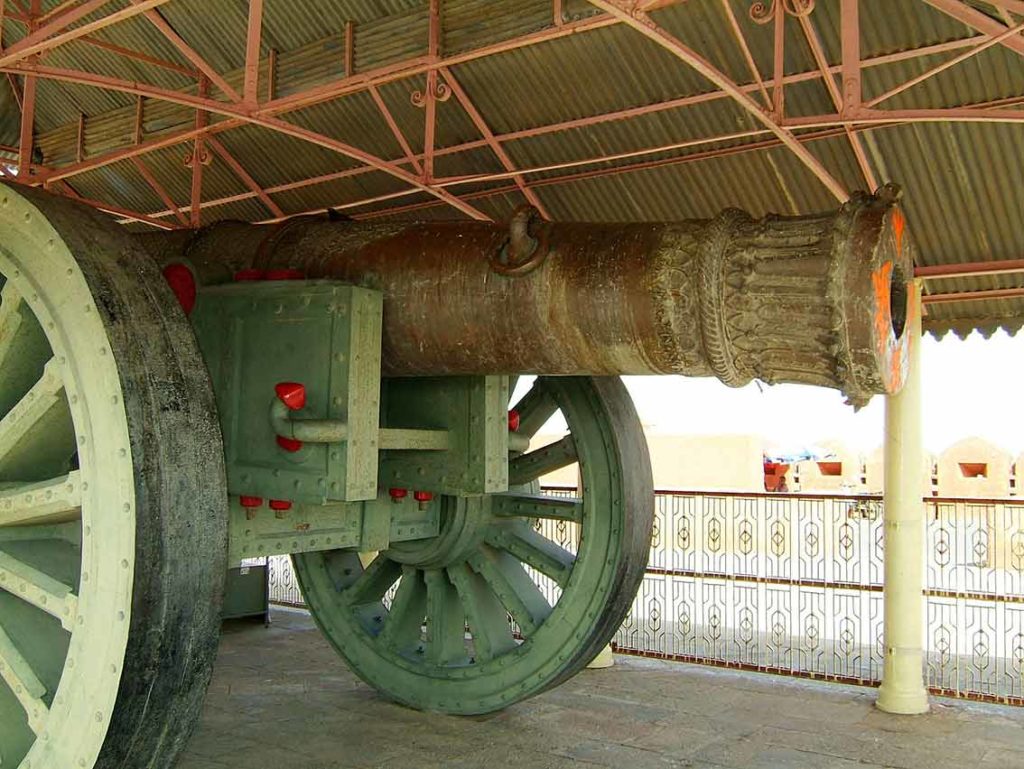
Sri Jagat Shiromaniji temple
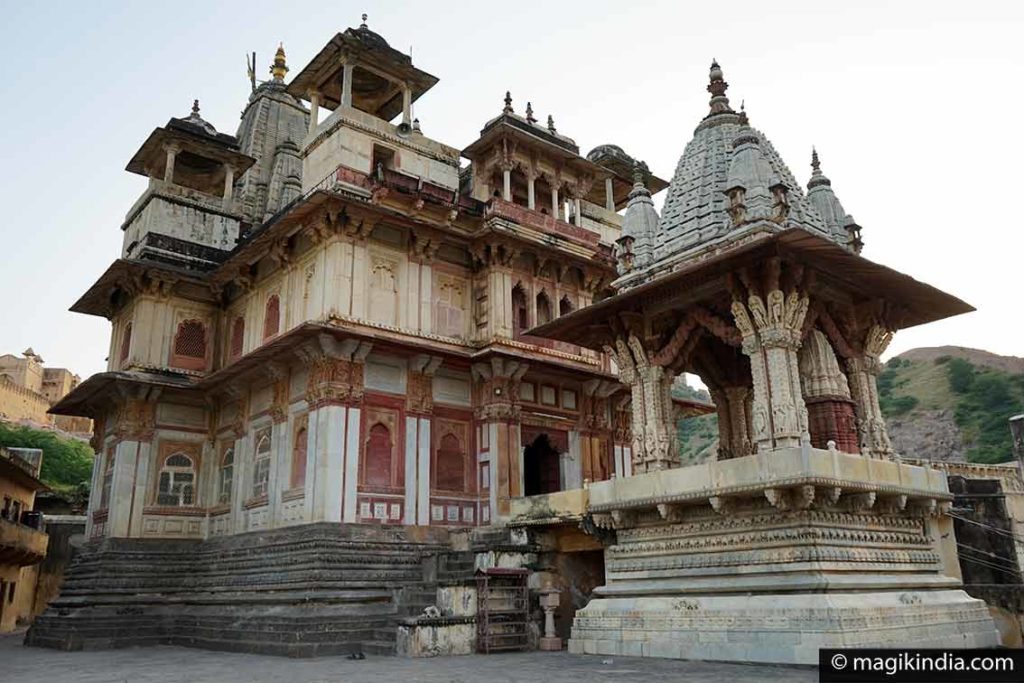
Below the Amber Palace there are several temples, the most important of them is the Sri Jagat Shiromaniji (crown of Lord Vishnu), dedicated to Lord Krishna. It was built in 1601 by Queen Kanakawati, wife of Maharaja Man Singh, in memory of her son Jagat Singh.
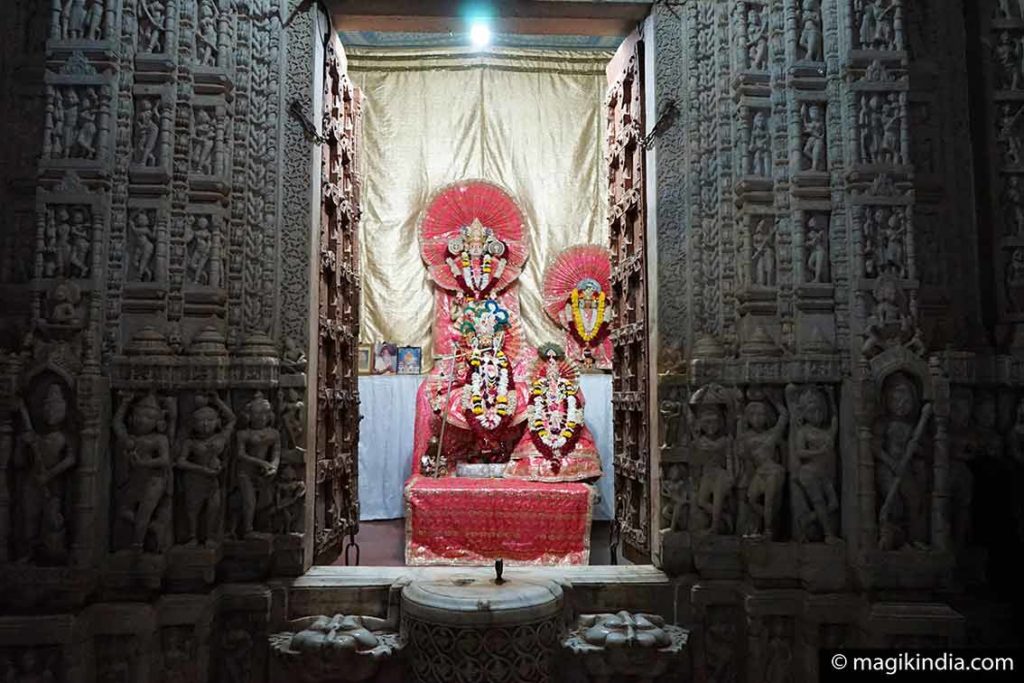
The palatal style temple is adorned with harmonious sculptures and includes a splendid torana (arch) at the entrance flanked by two elephants finely carved in white marble.
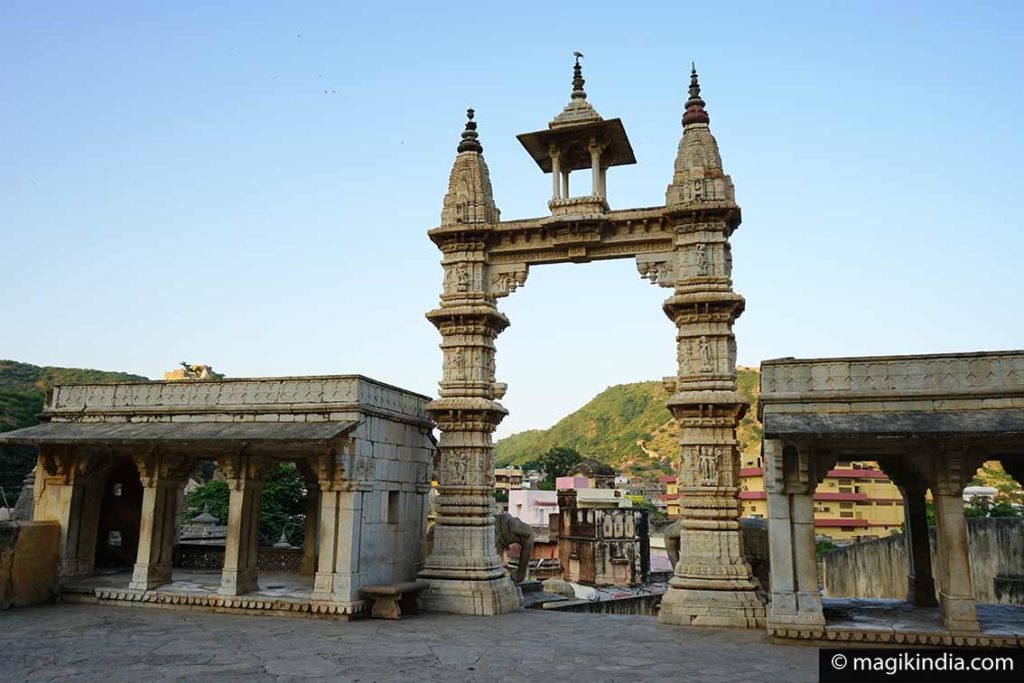
This temple is also associated with the holy poetess Meerabai. It is said that the statue of Krishna of this temple is the very one that Meerabai worshiped. She would have been saved from destruction by the rulers of Amer during the wars against the Mughals and placed in this temple.
Panna Meena Ka Kund
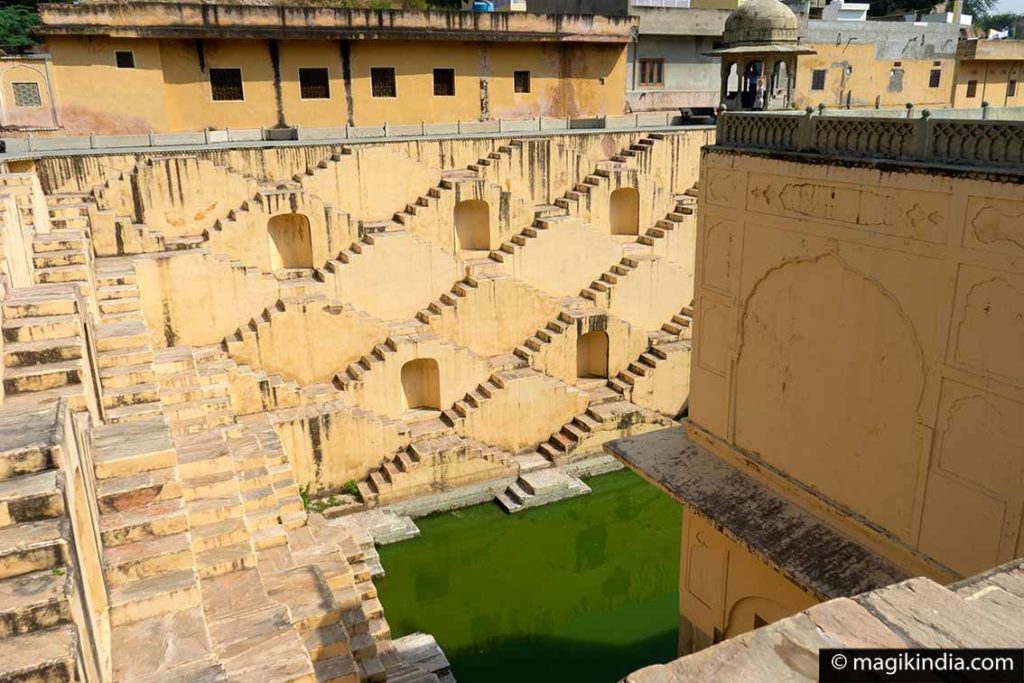
At the bottom of the Sri Jagat Shiromaniji temple, we discover the Panna Meena Ka Kund, a fine example of a step-well, typical of Rajasthan.
It was built in the 16th century and was both a water supply and a gathering place for the local community.
Its perfect geometry, with intersecting staircases and numerous niches, is a delight to the eye. But, if you want to see the largest step-well of Rajasthan, the Chand Baori, you will have to continue your road towards Agra …
Temples Galtaji Monkey (10 km)
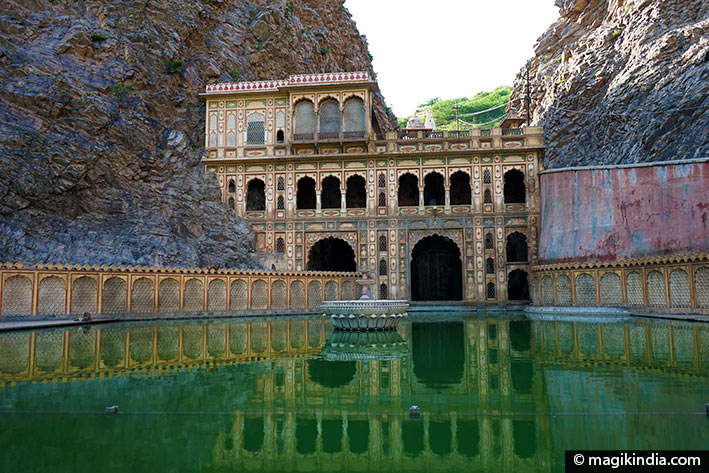
To finish off the tour of Jaipur in style, I recommend you a drive to the heart of the Aravallis mountains to discover the temples of Galtaji built in between two cliffs, there are little gems.
The complex is an ancient place of pilgrimage; it is said that a saint named Galav, whose place takes his name, lived here for 100 years practicing intense asceticism. Since the 16th century, it has also been the home of followers of the Hindu branch ‘Ramanandi Sampradaya’ which mainly emphasizes the worship of the god Rama and all the other incarnations of the god Vishnu.
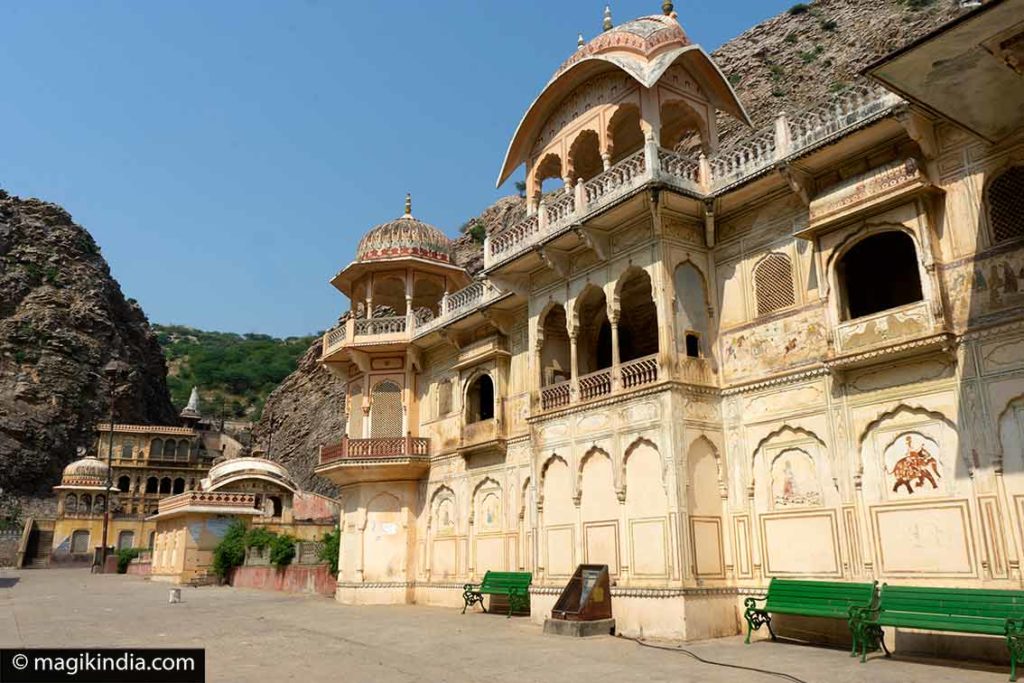
The current temple was built in the 18th century under the reign of Maharaja Sawai Jai Singh II and it is also the home of thousands of monkeys, hence its second name. Besides its many temples, it also includes 7 Kunds (ponds) which are fed by a source of pure water gushing from the cliff and flowing into a first basin, the ‘Galta Kund’, at the top of the complex. Taking a bath in this sacred pool is considered a blessing.
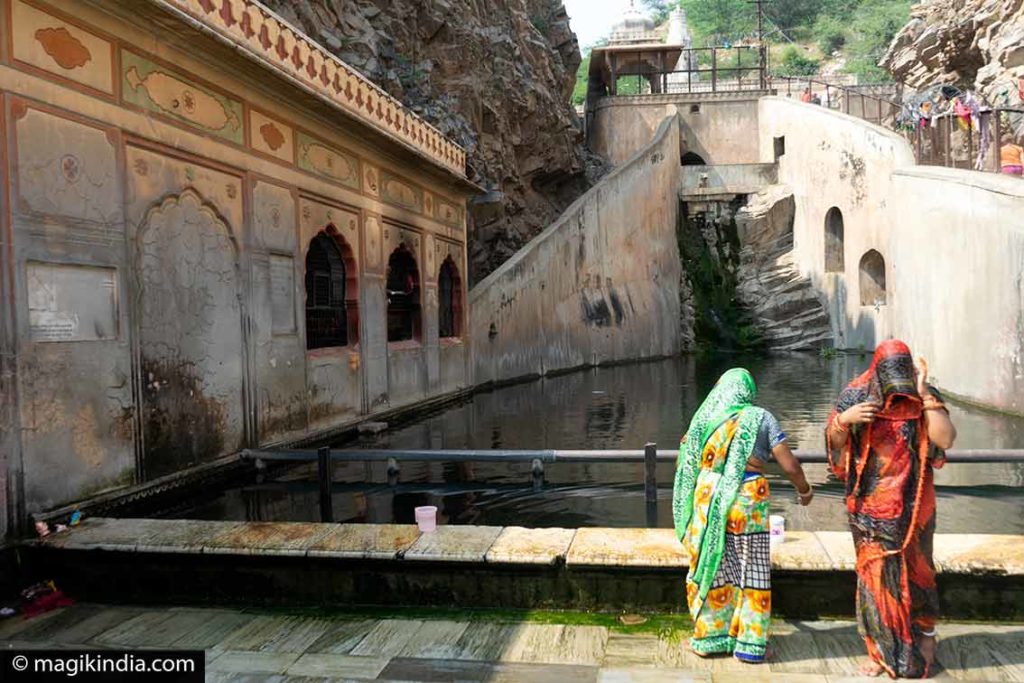

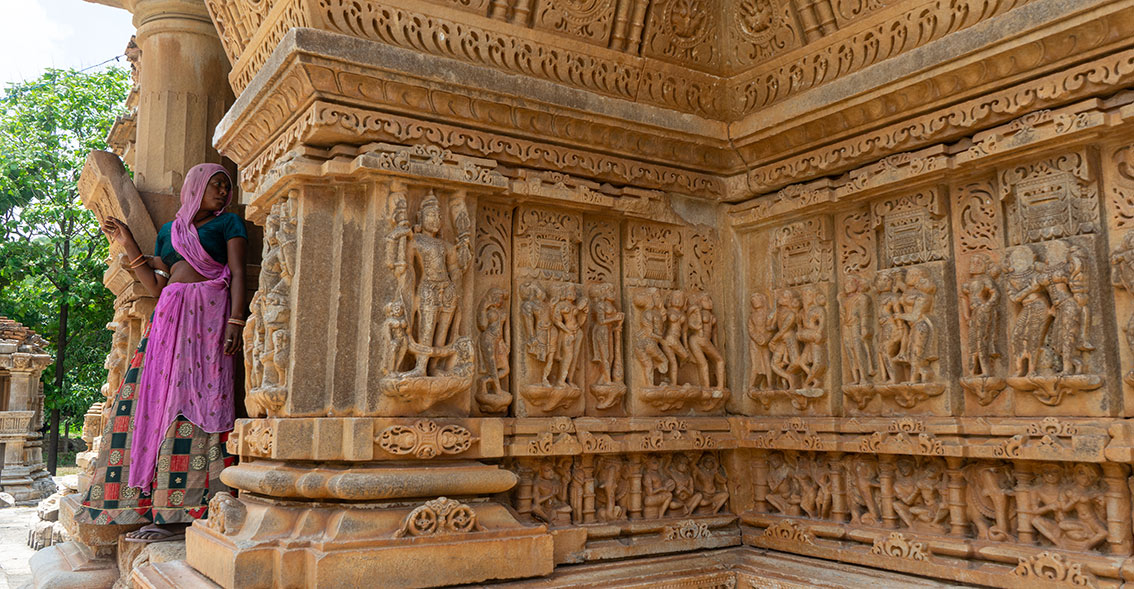

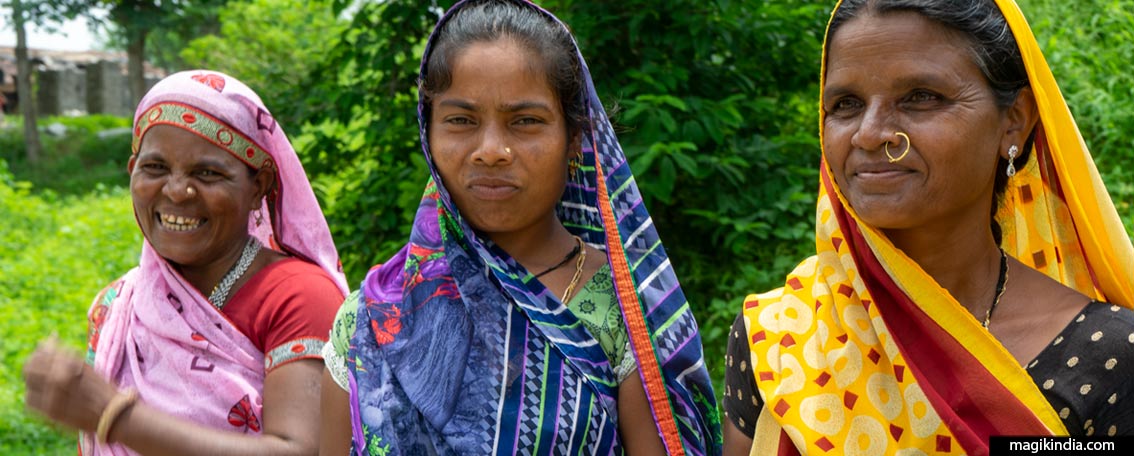

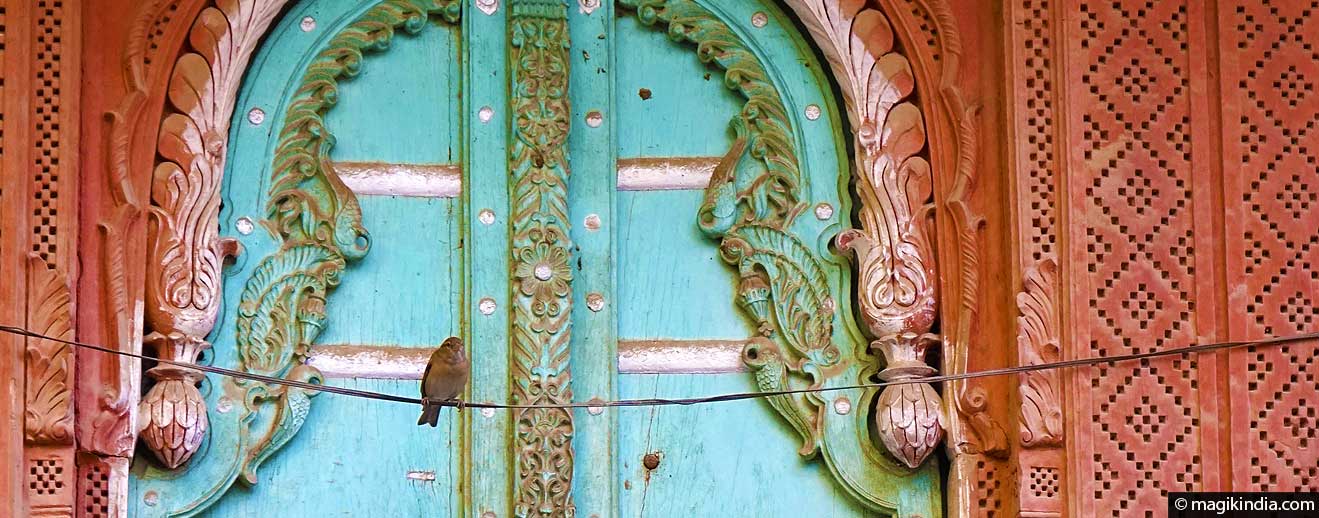
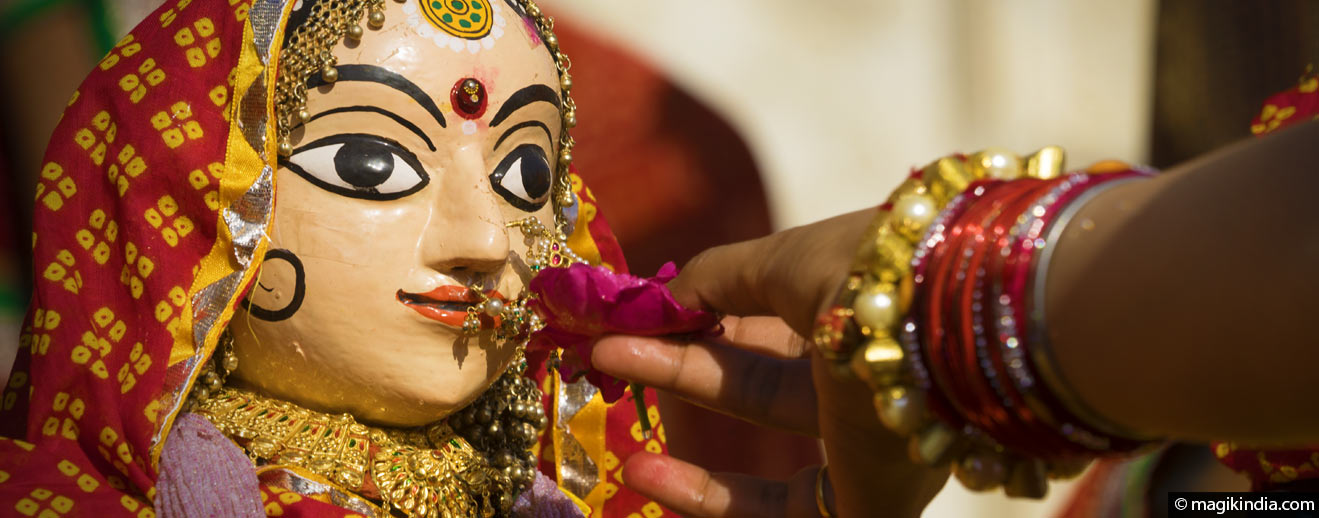
Really Very Helpful Articles For Every One,Thanks For Sharing Keep Up The Good Work
thanks ! 🙂